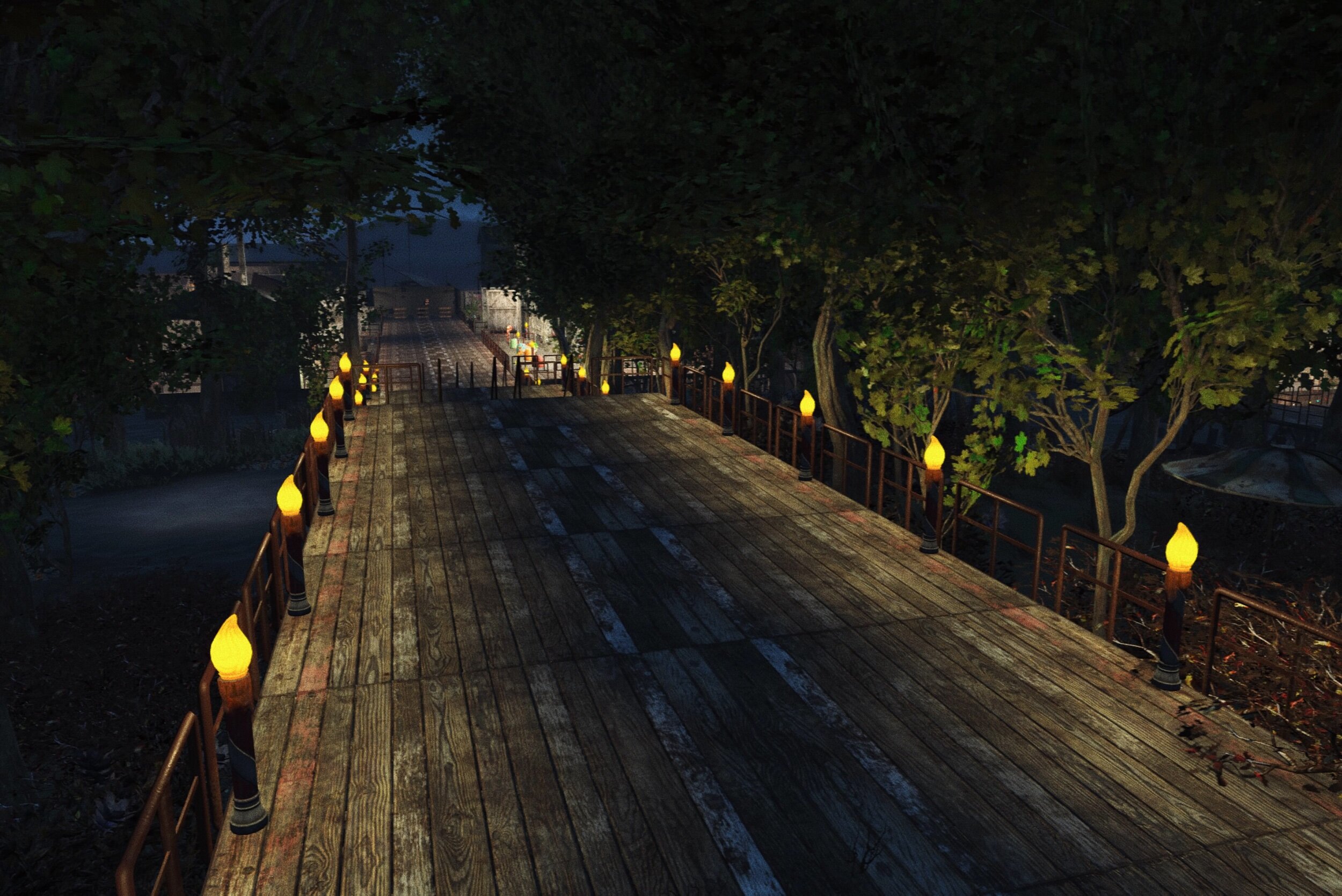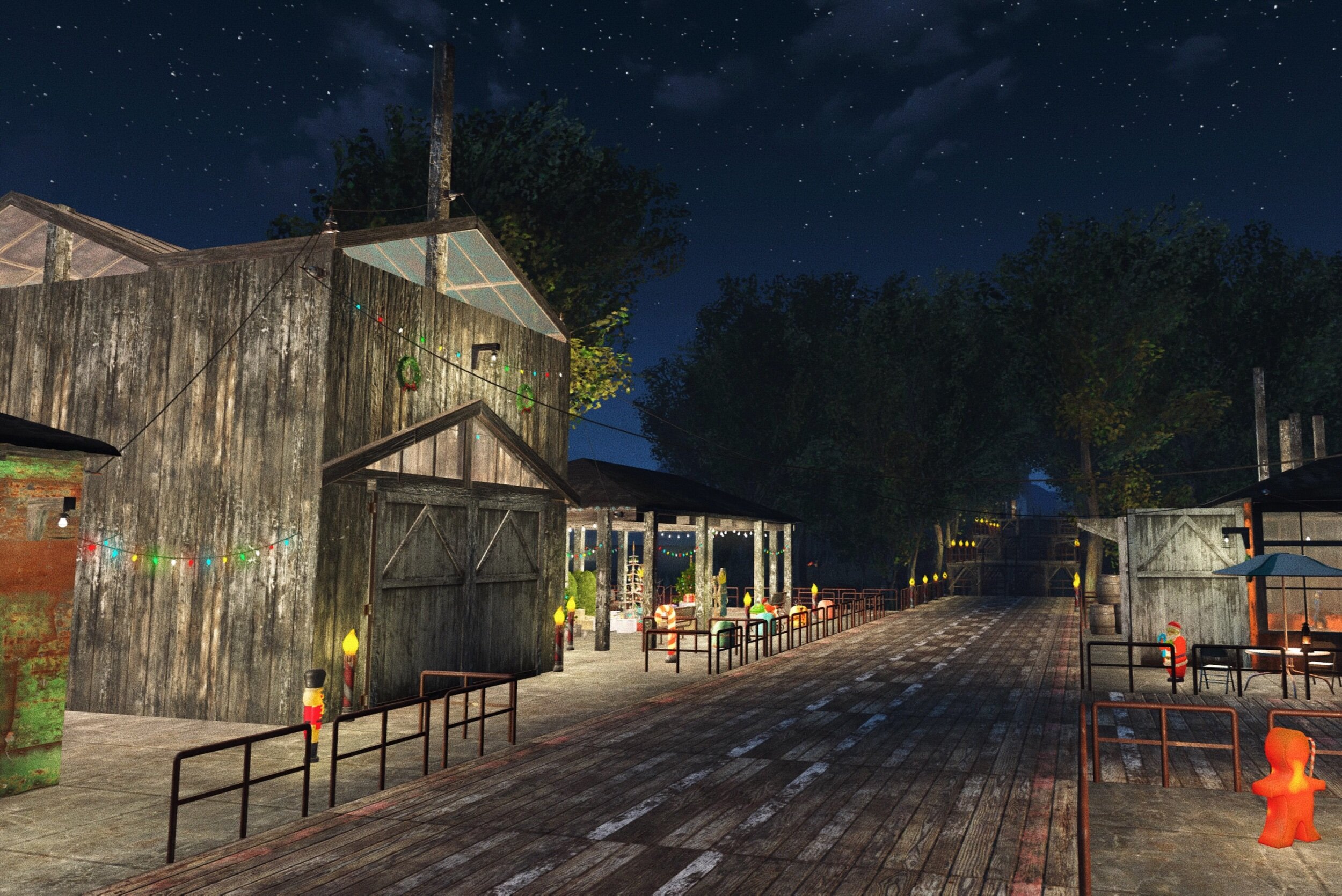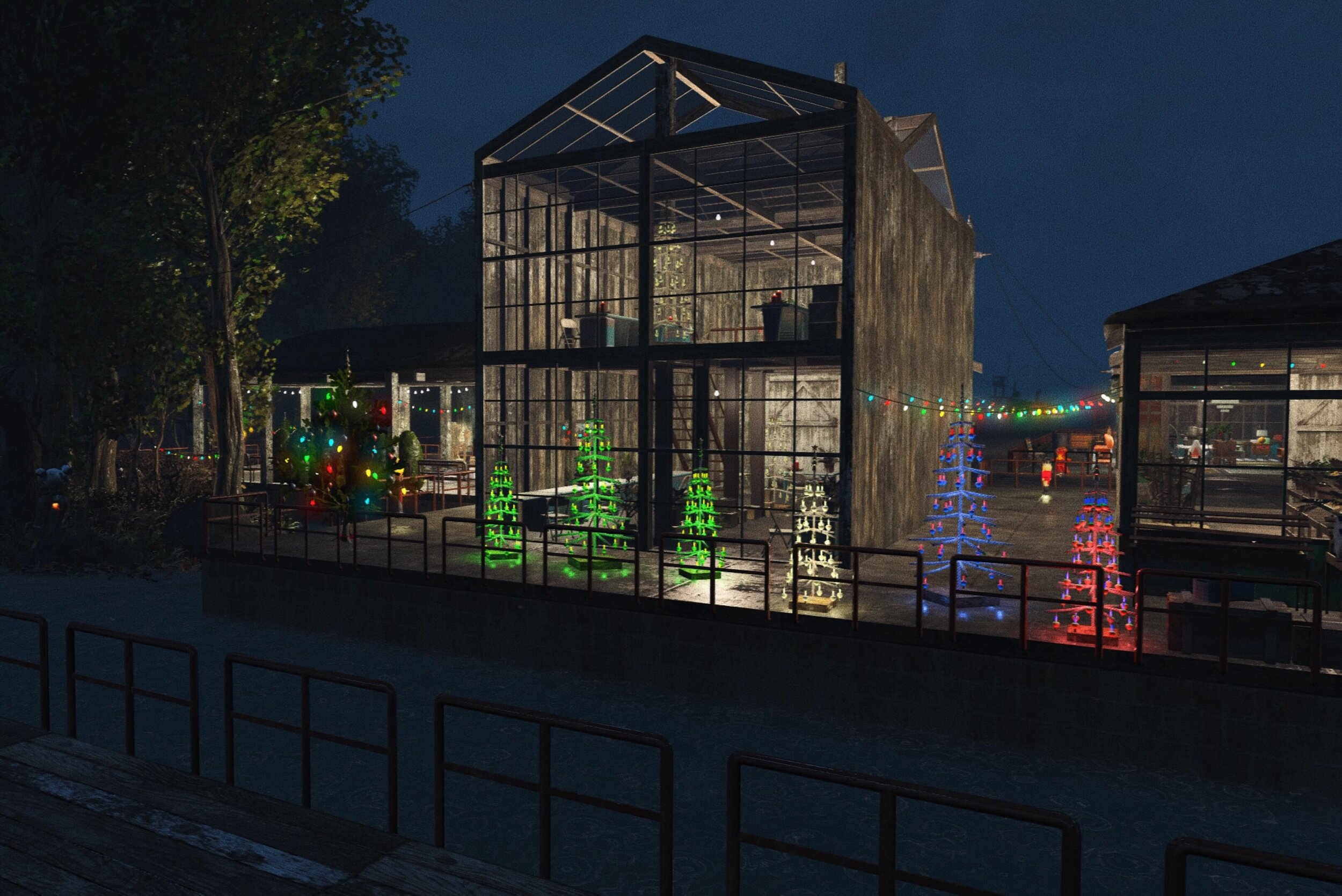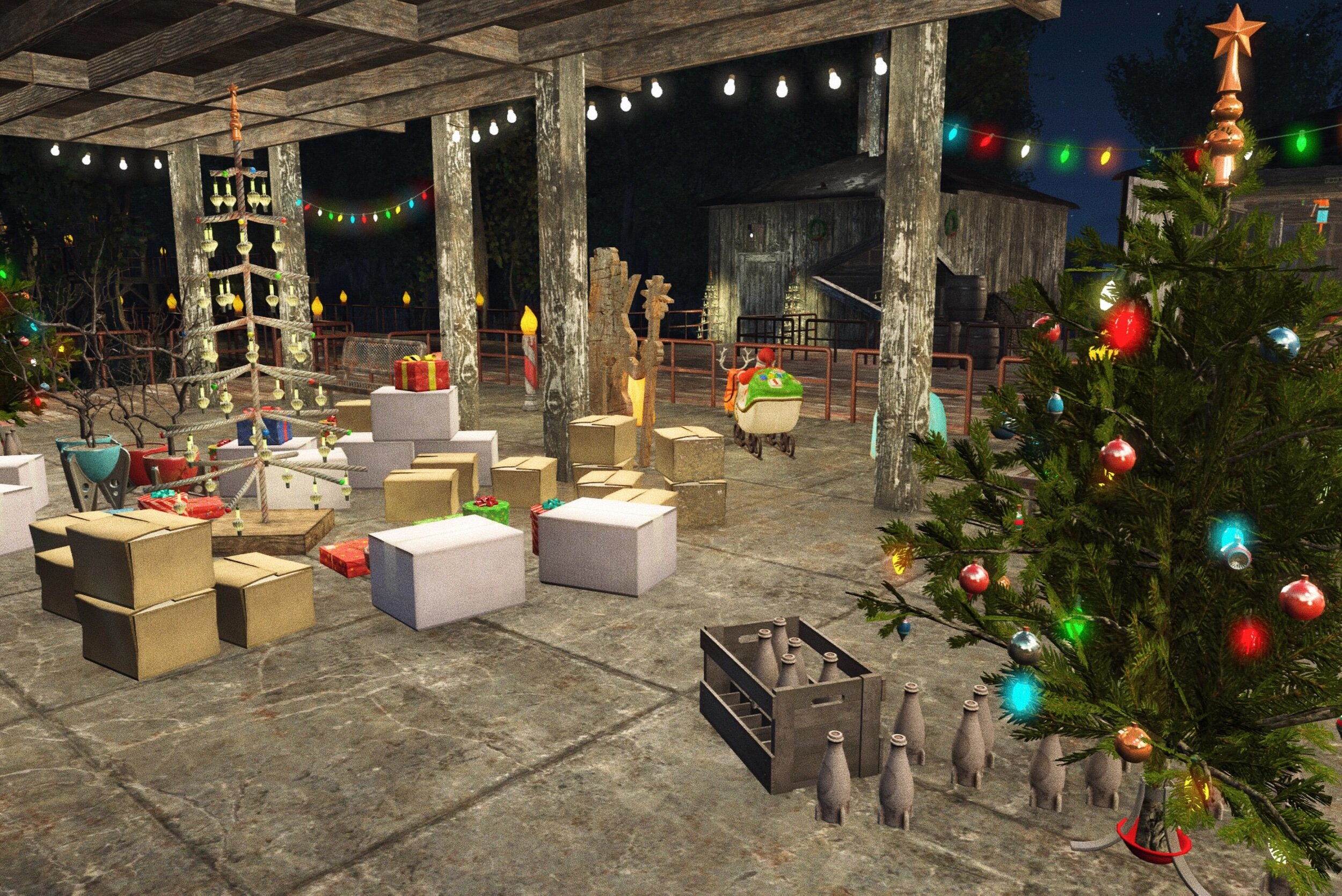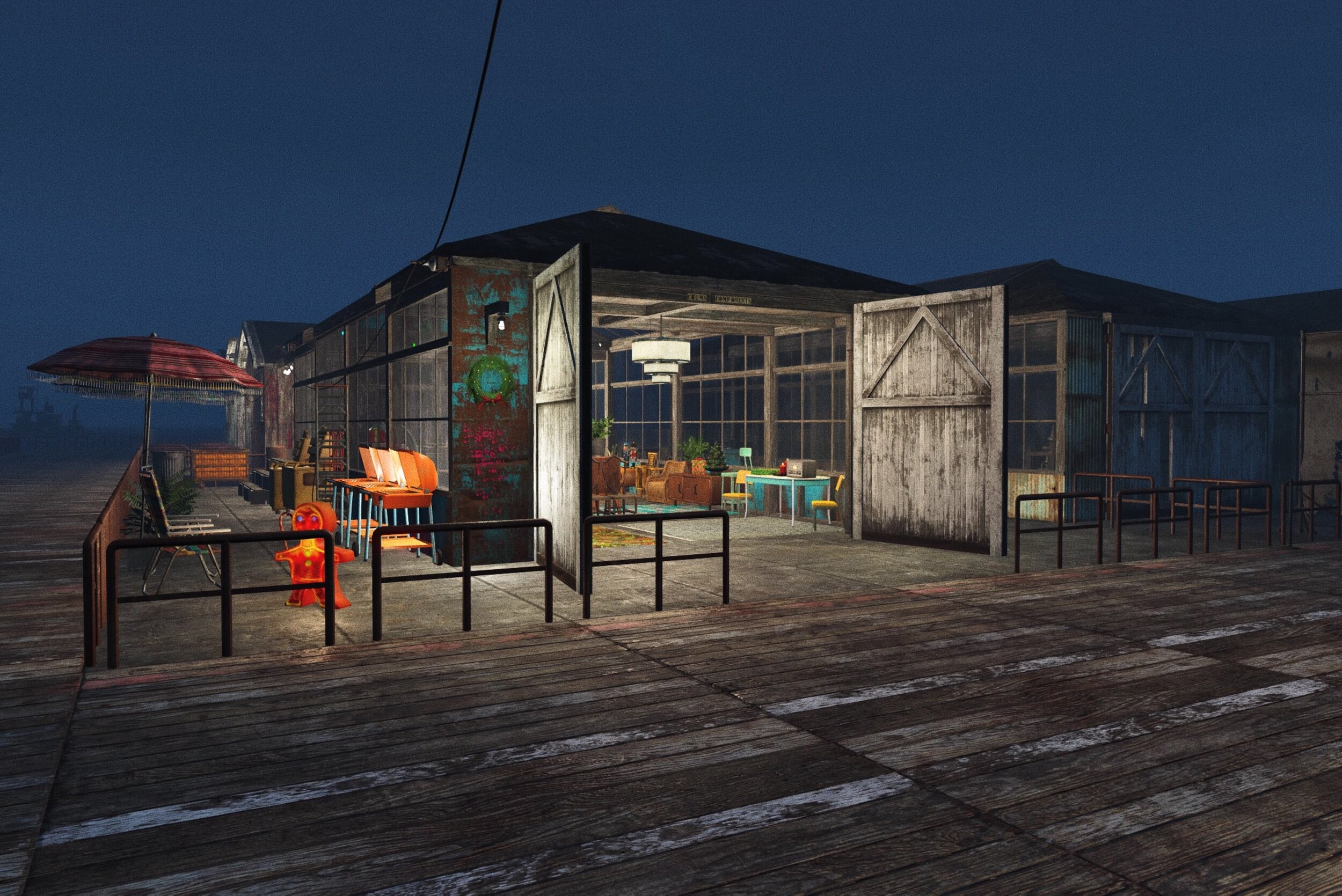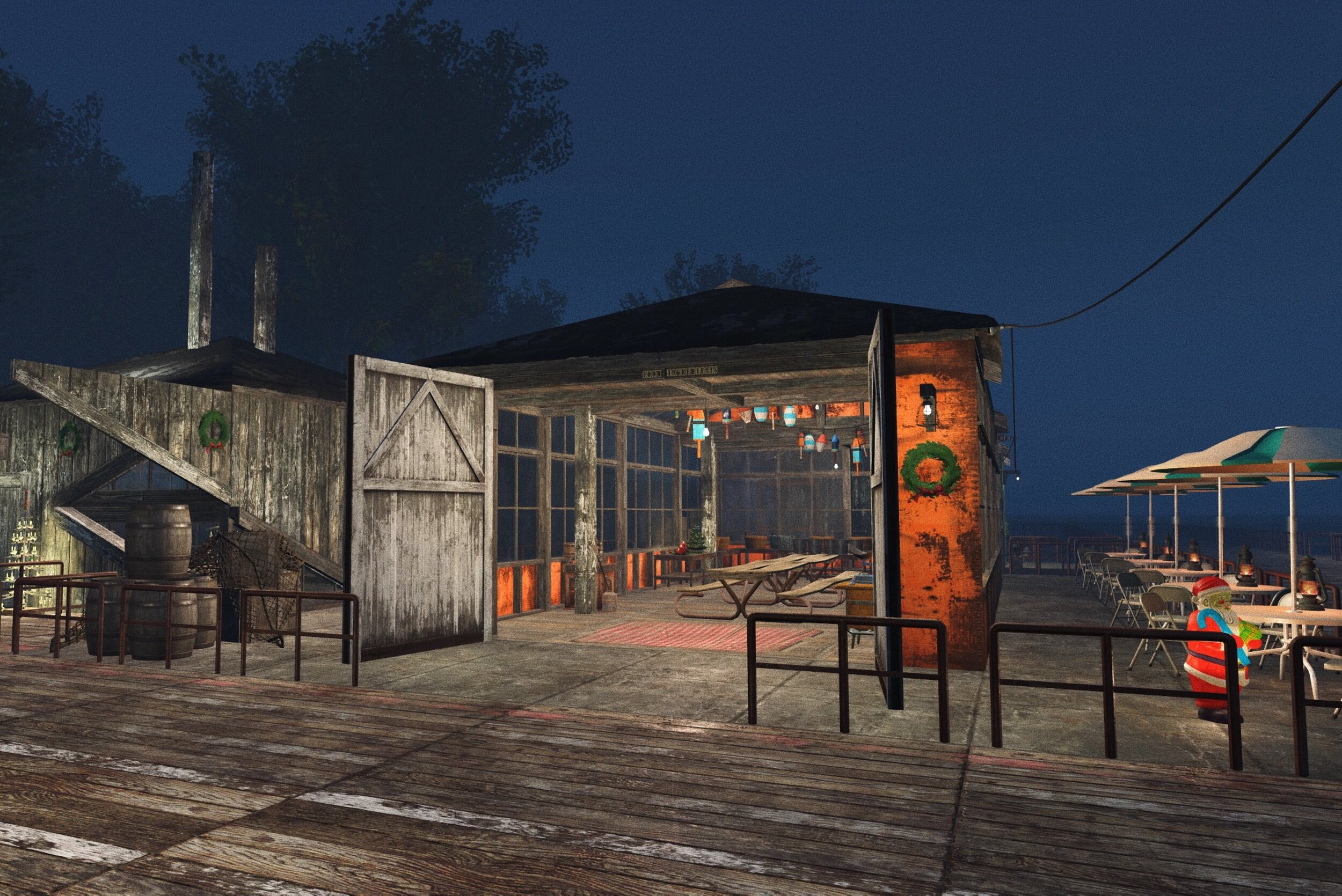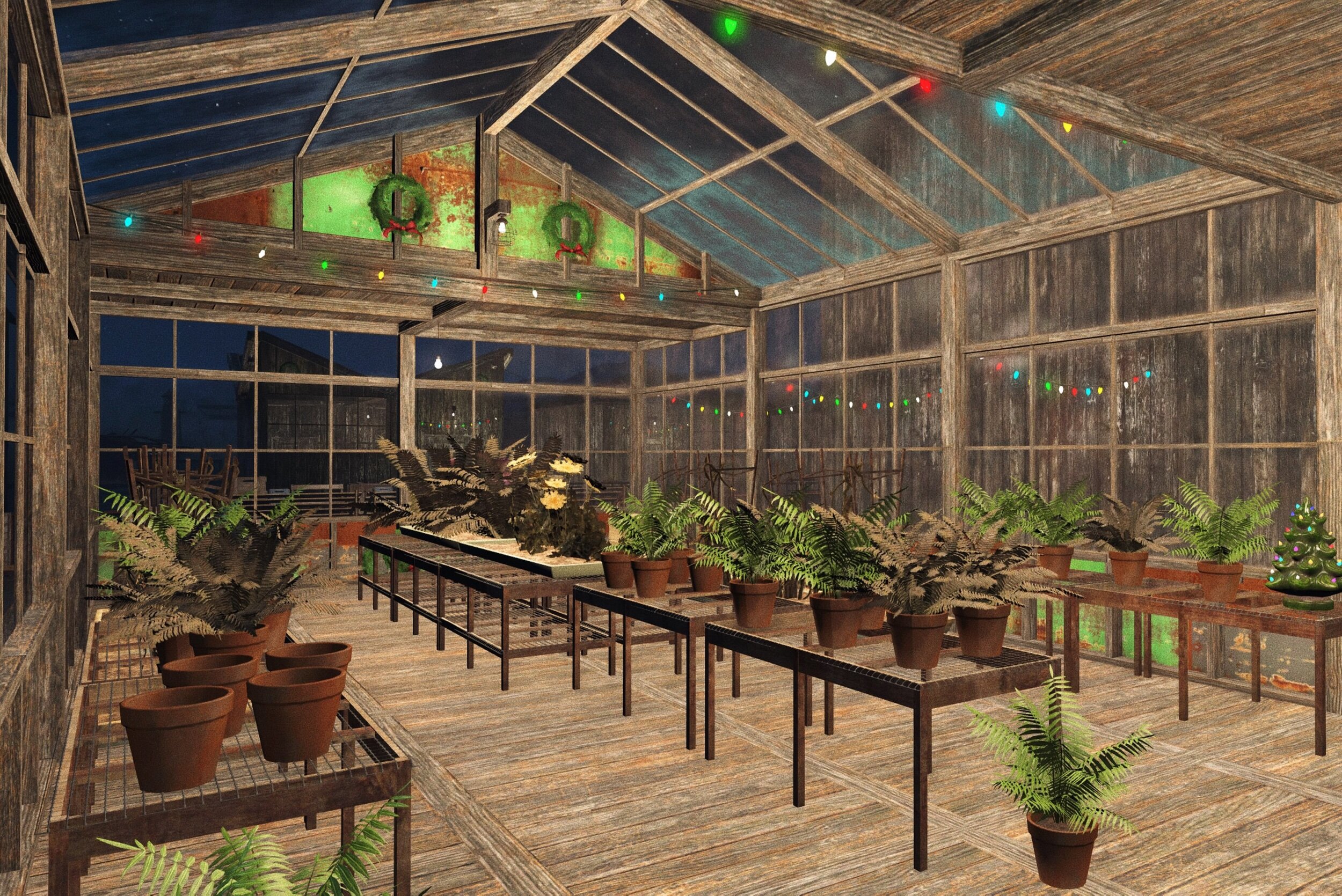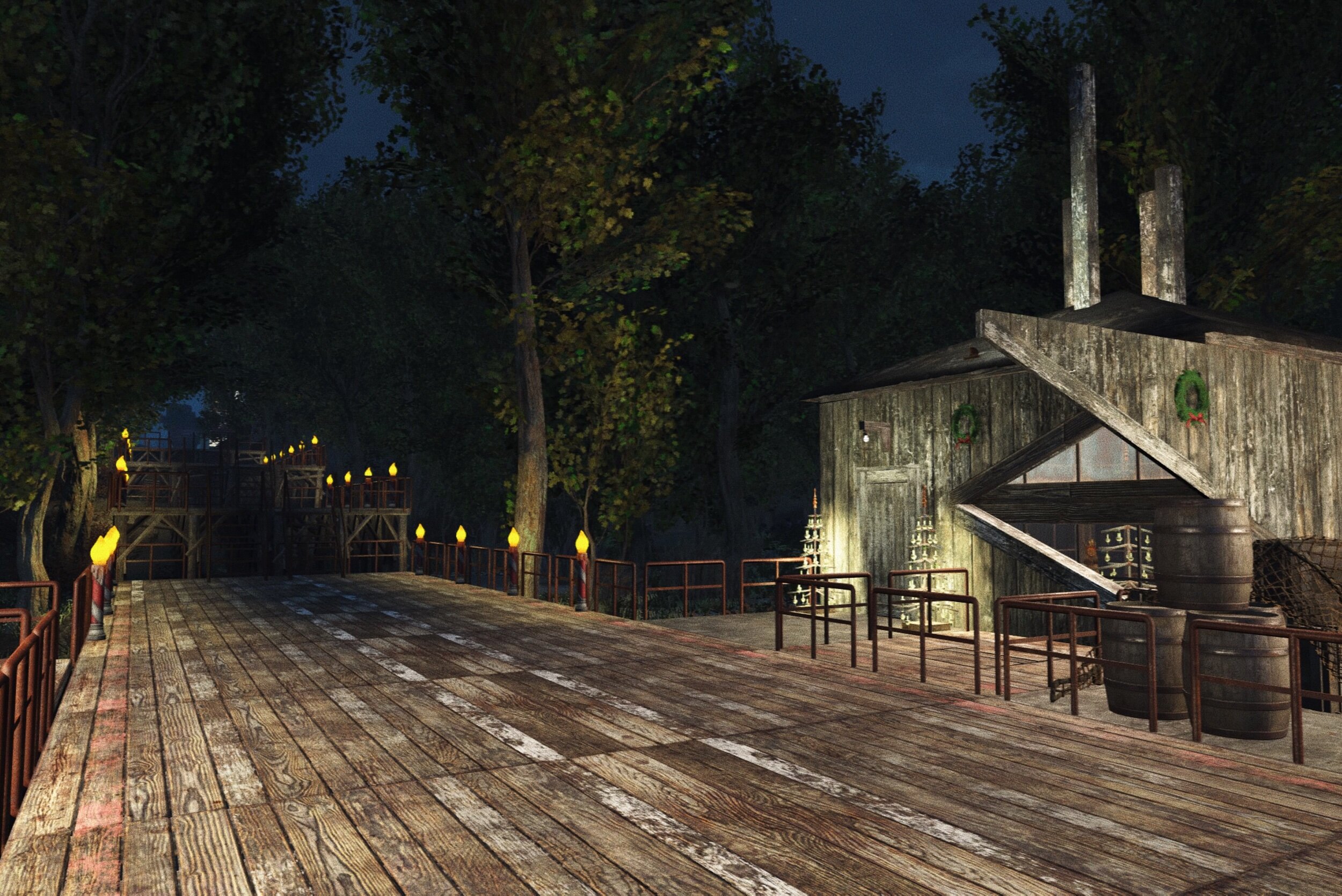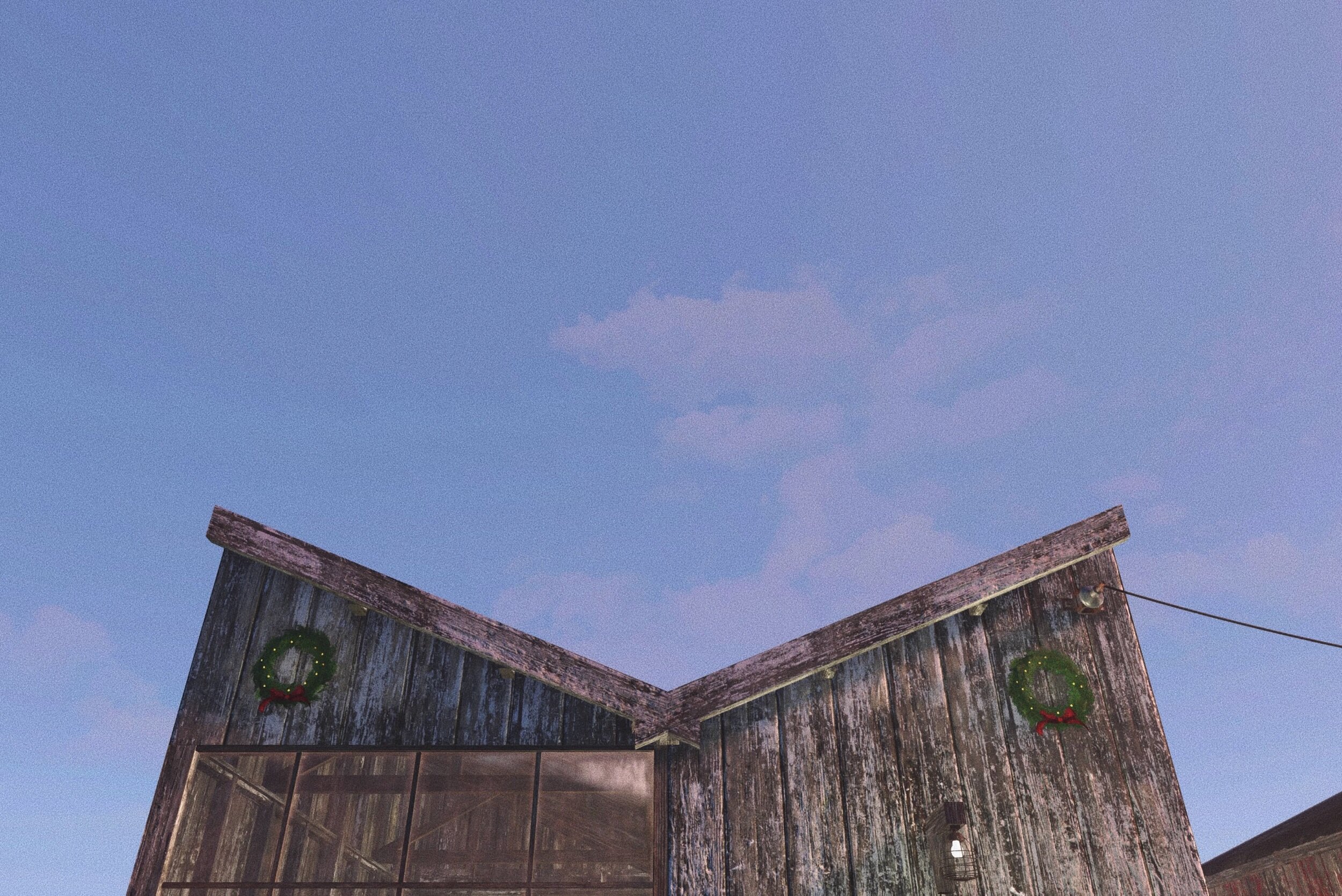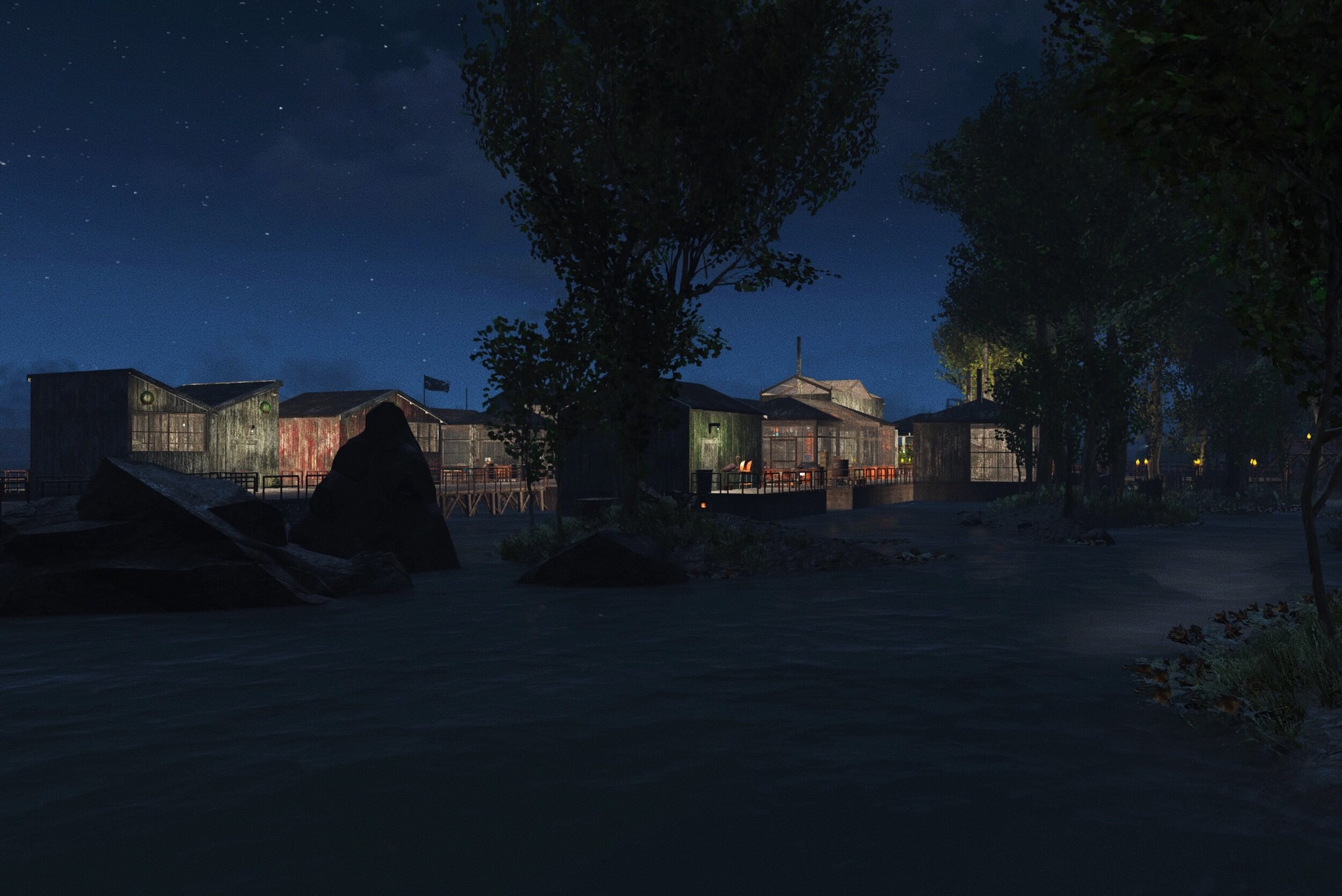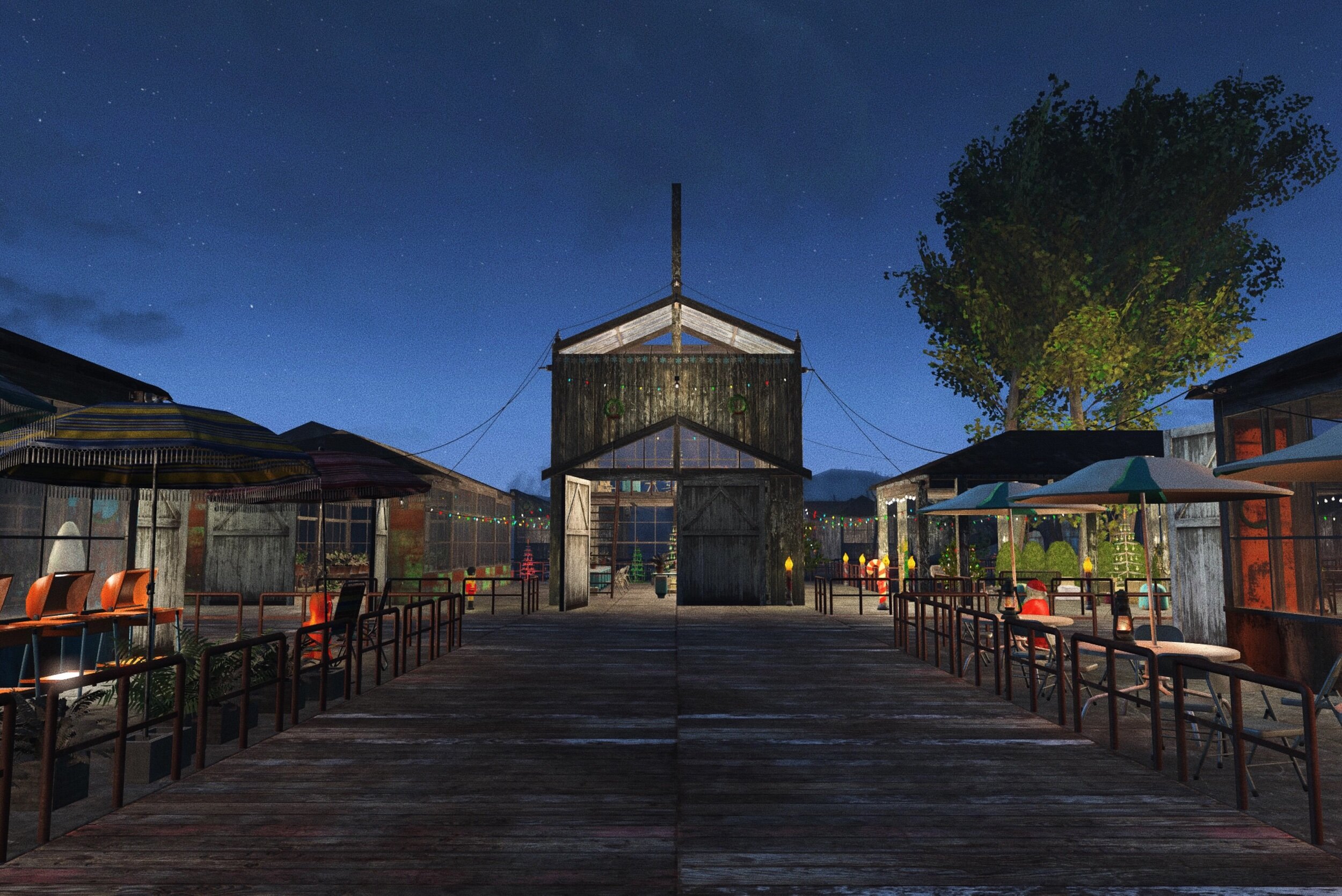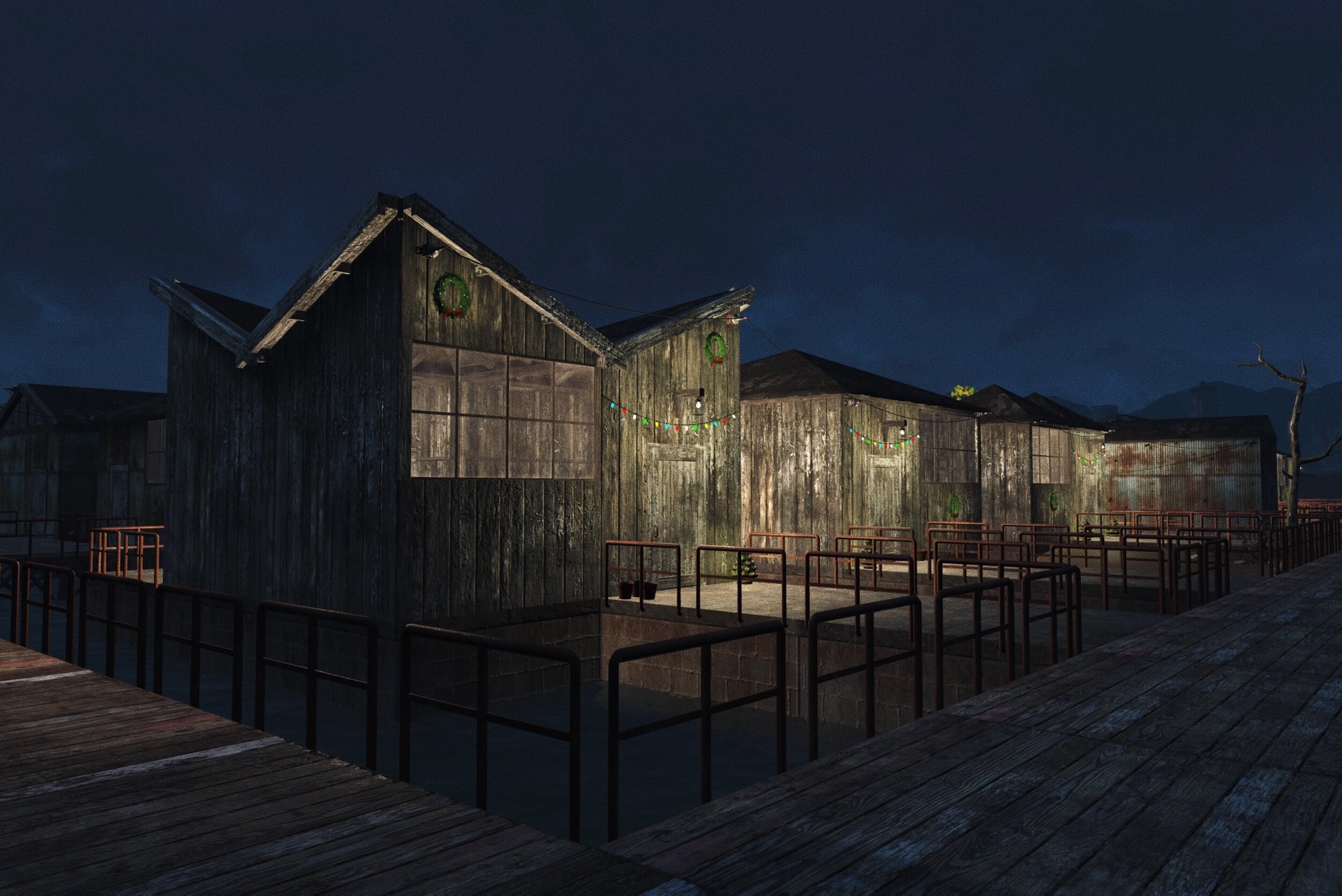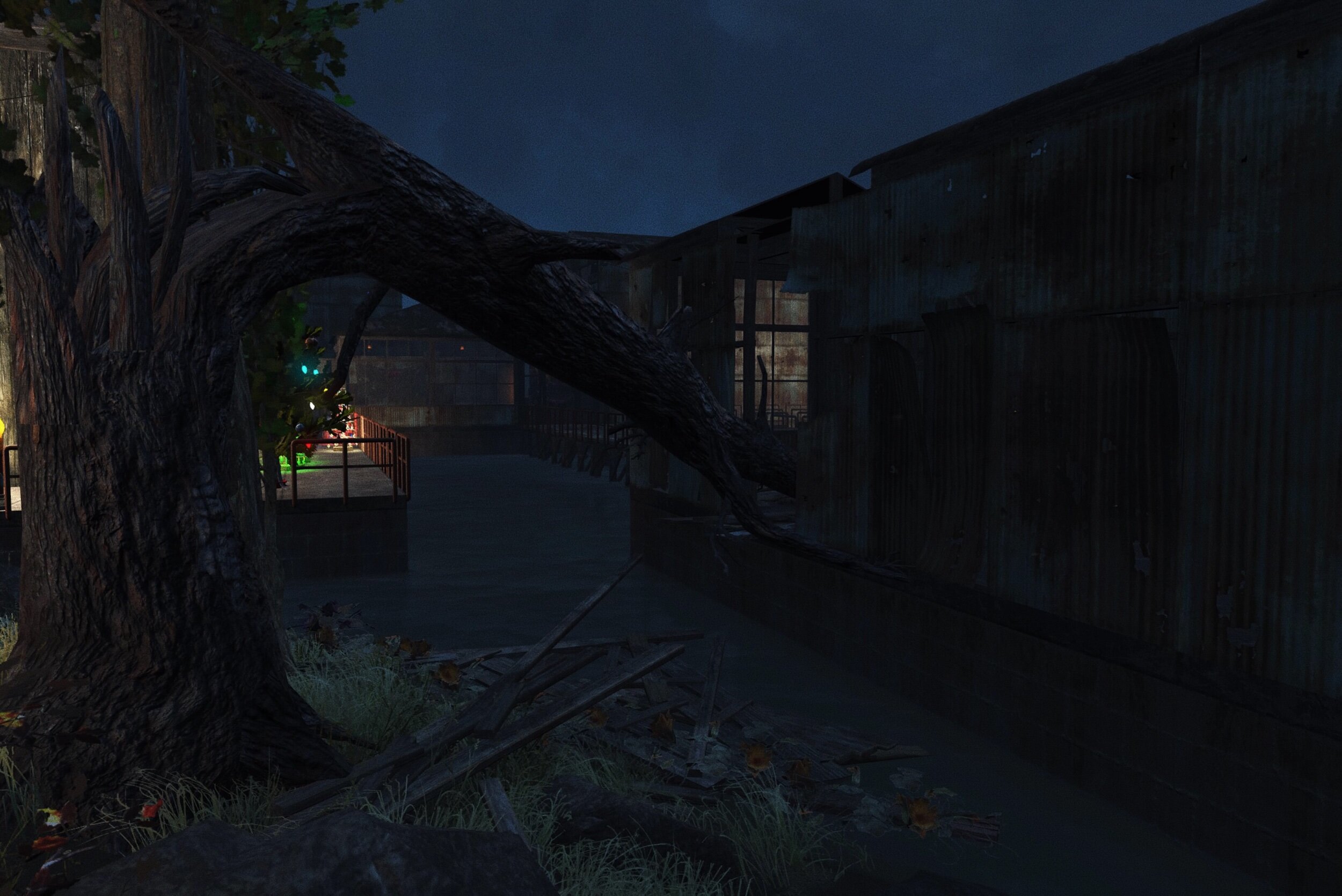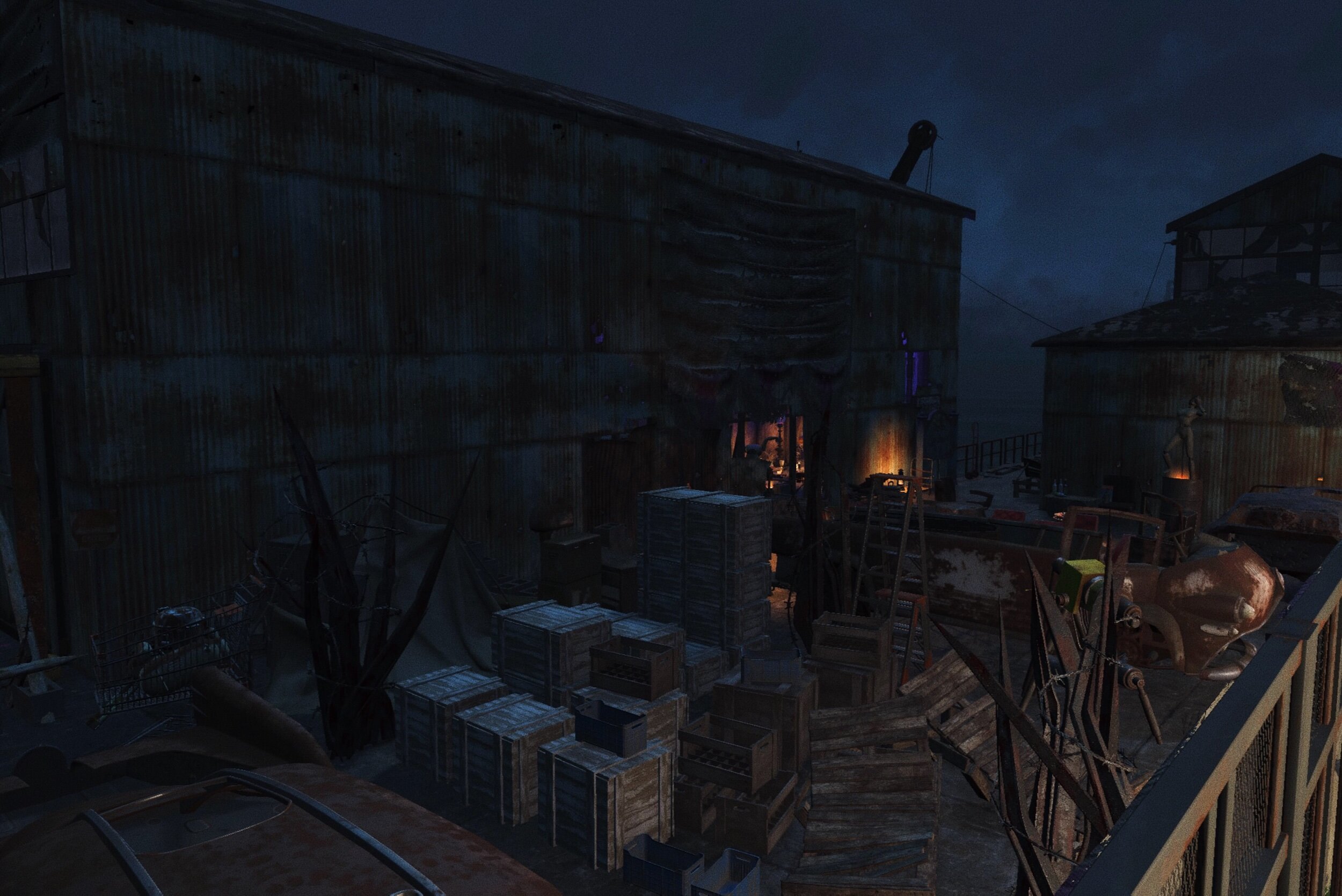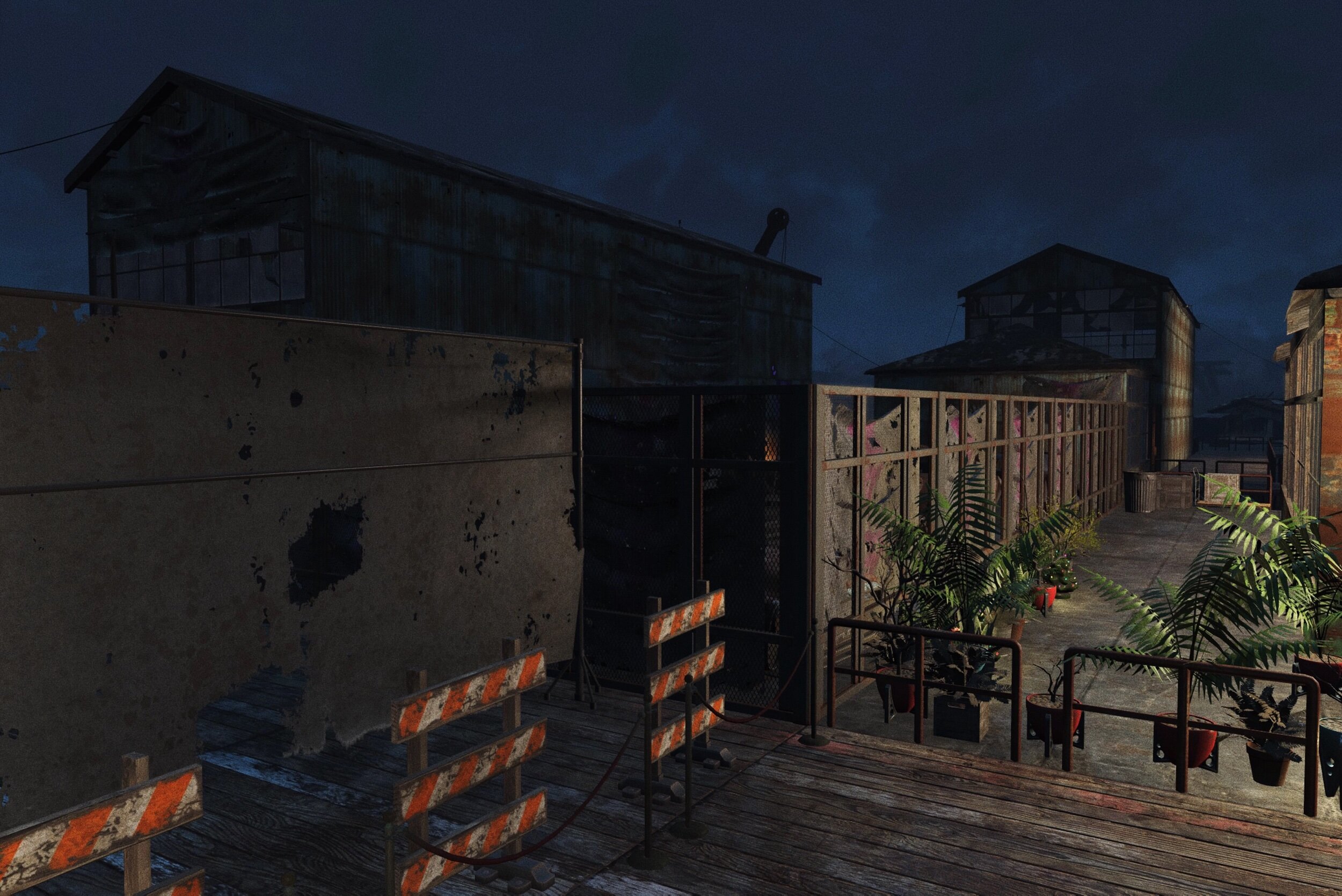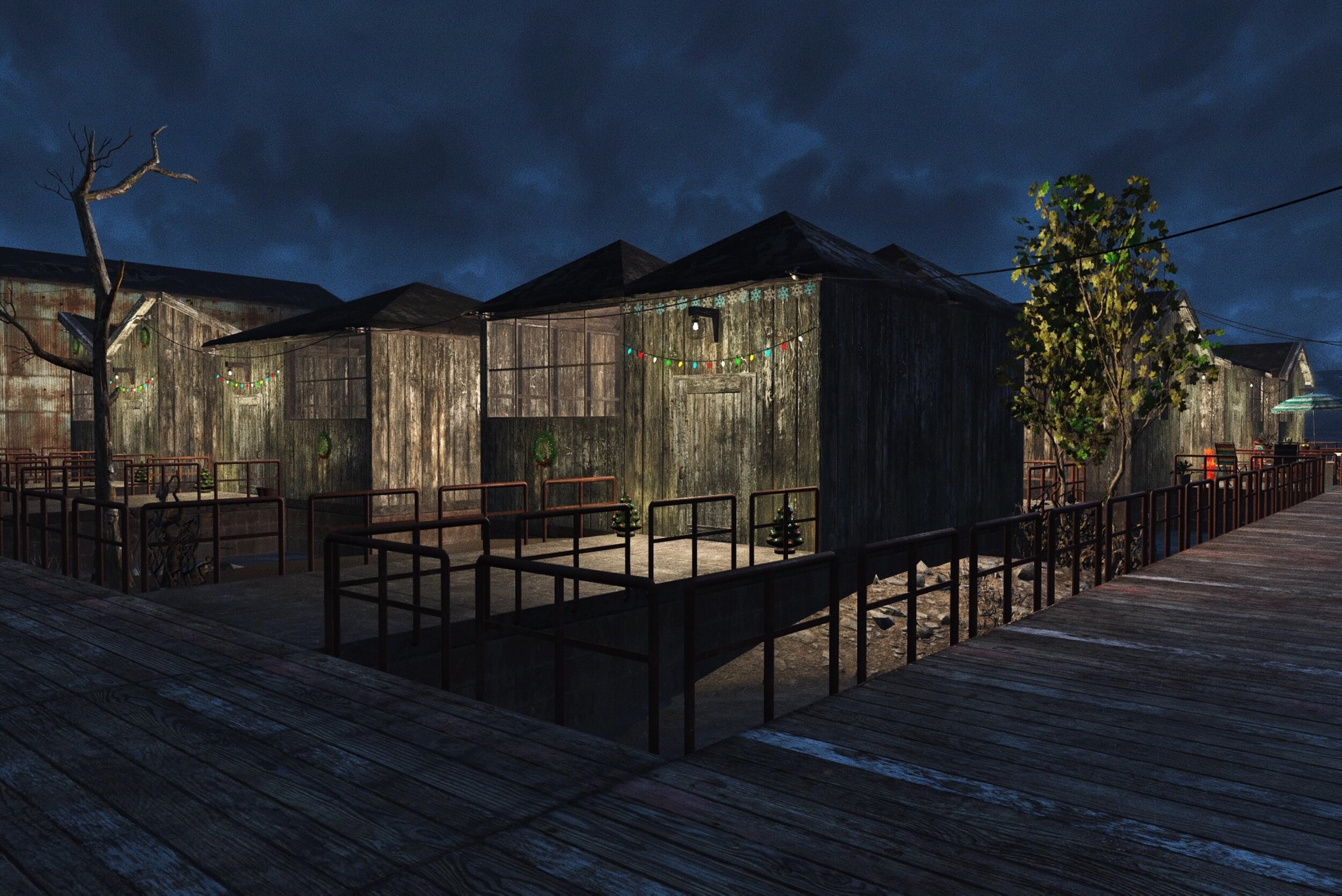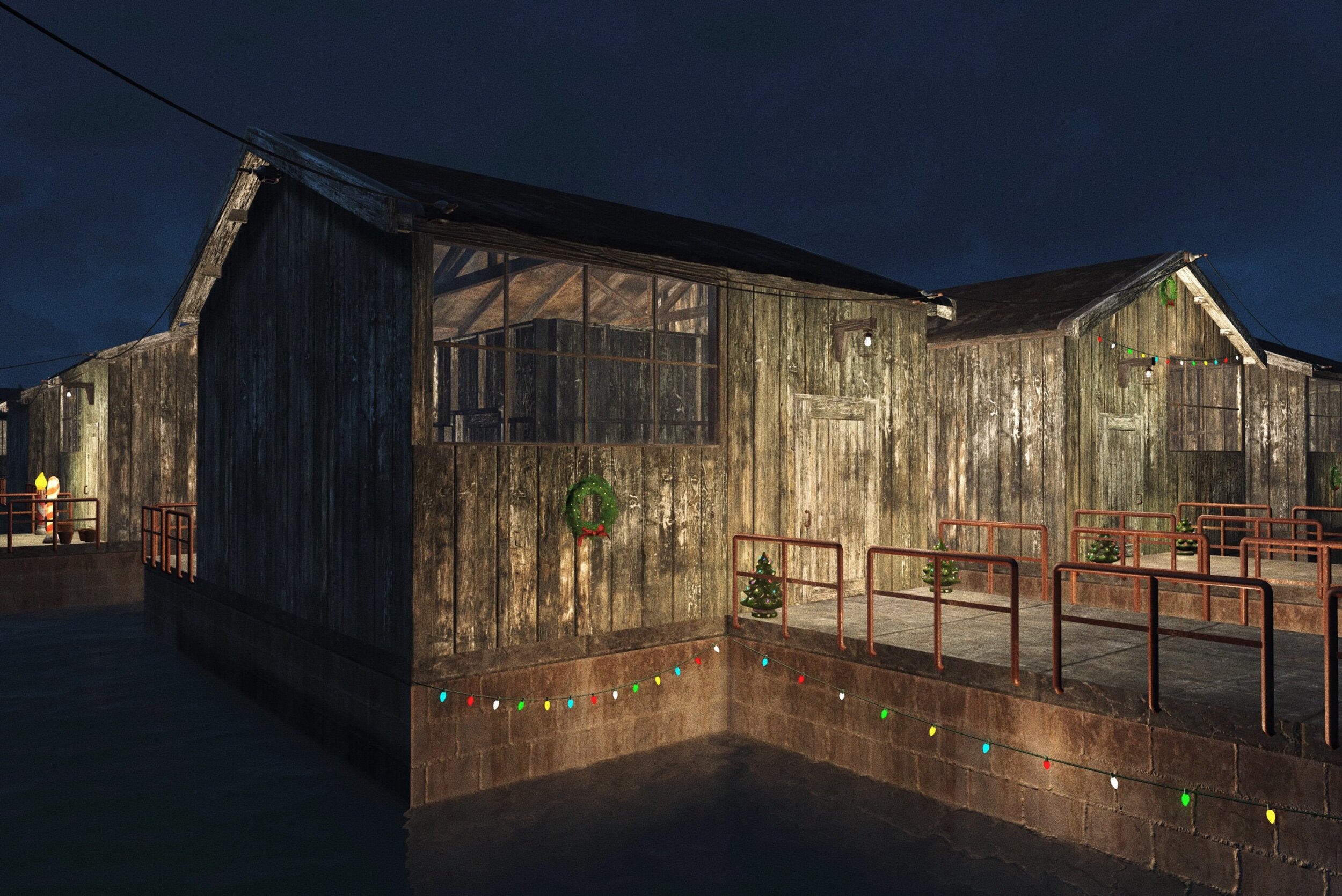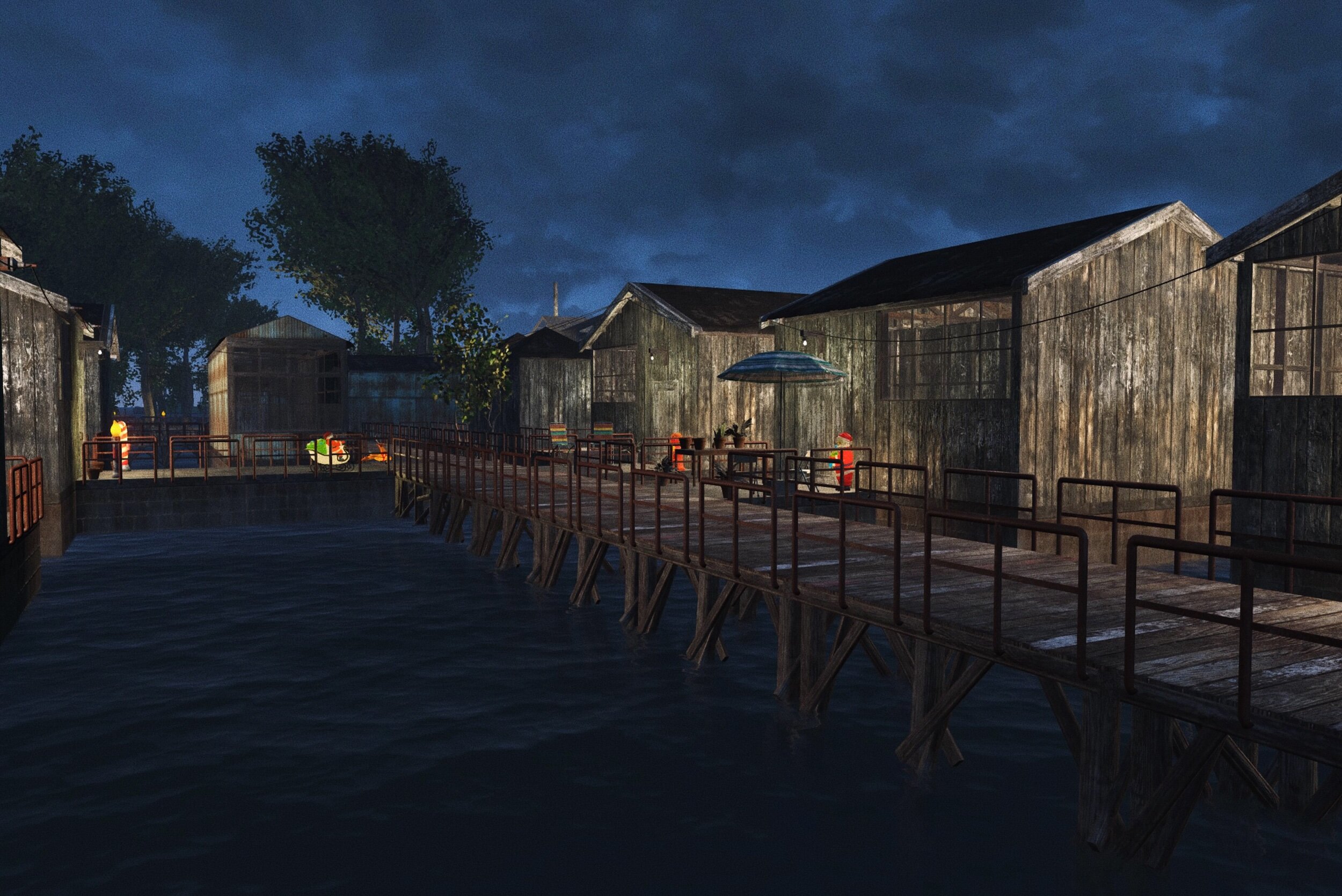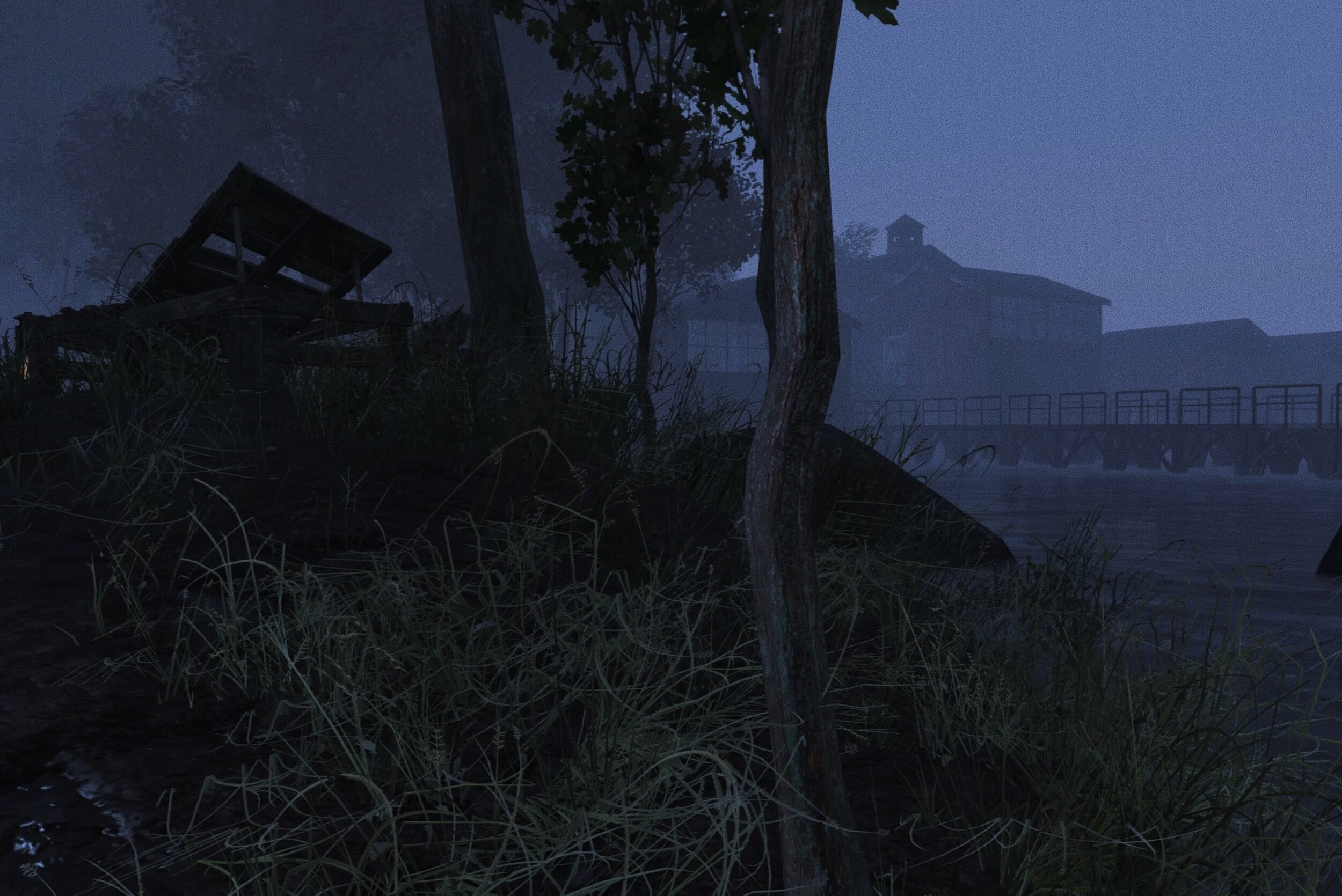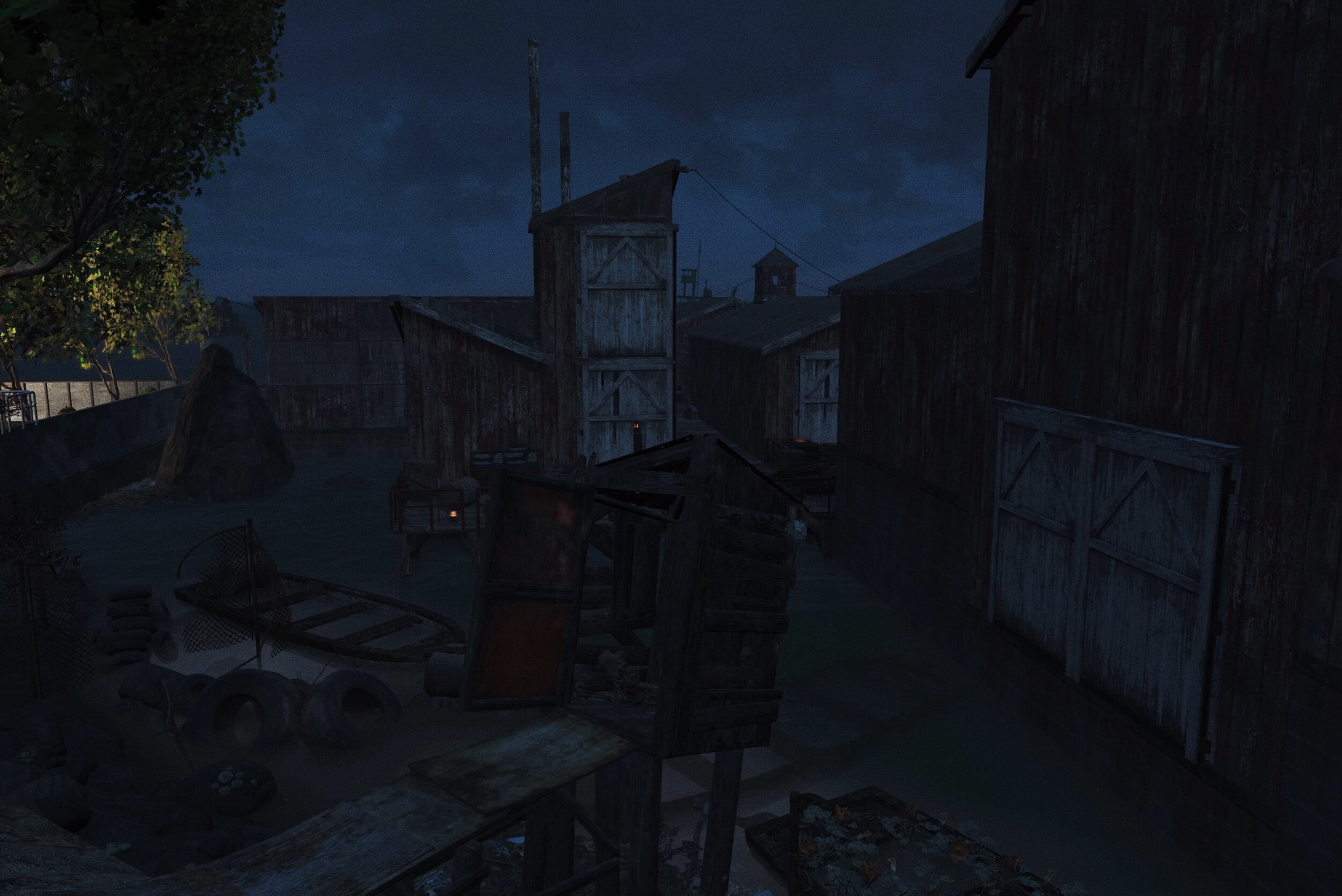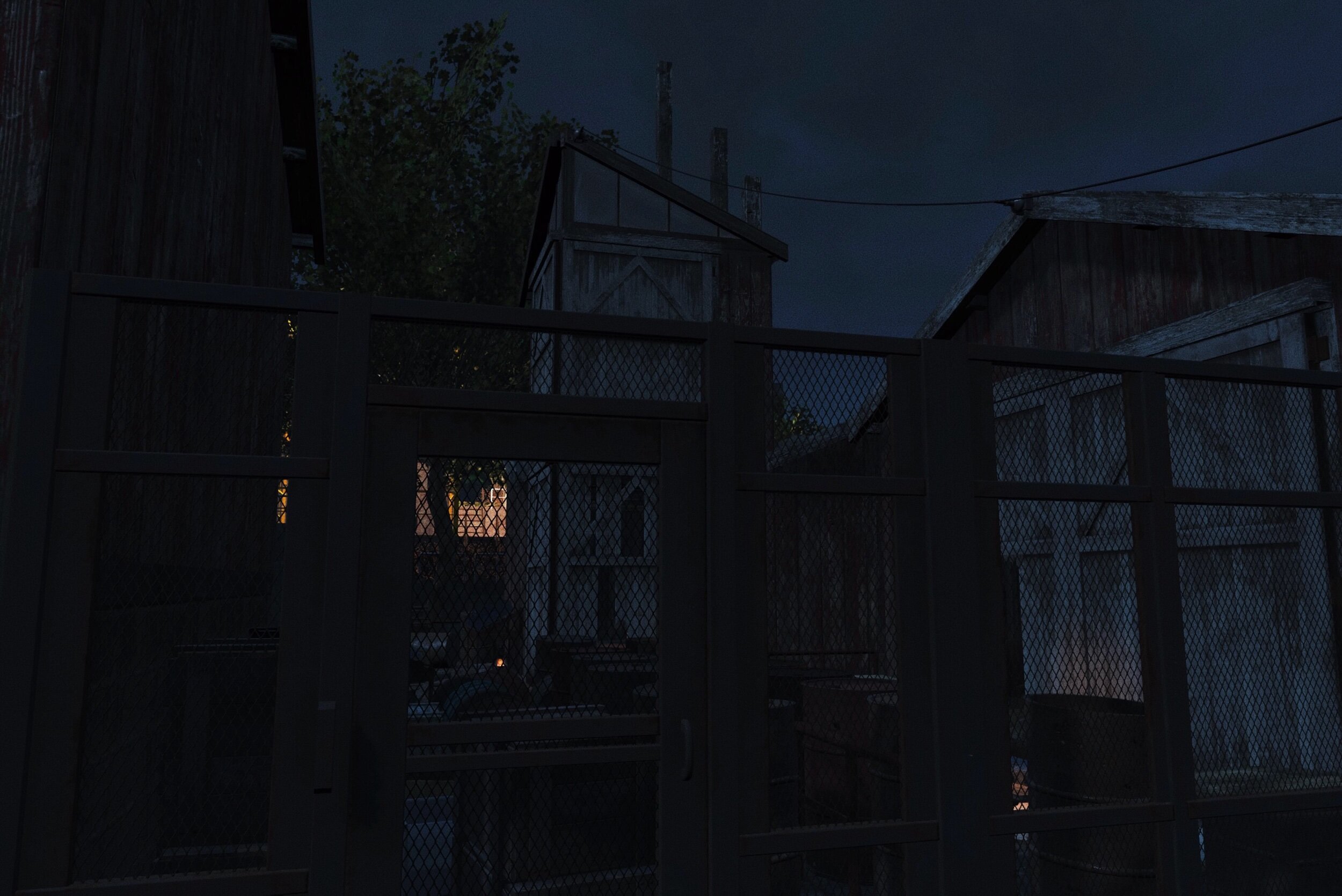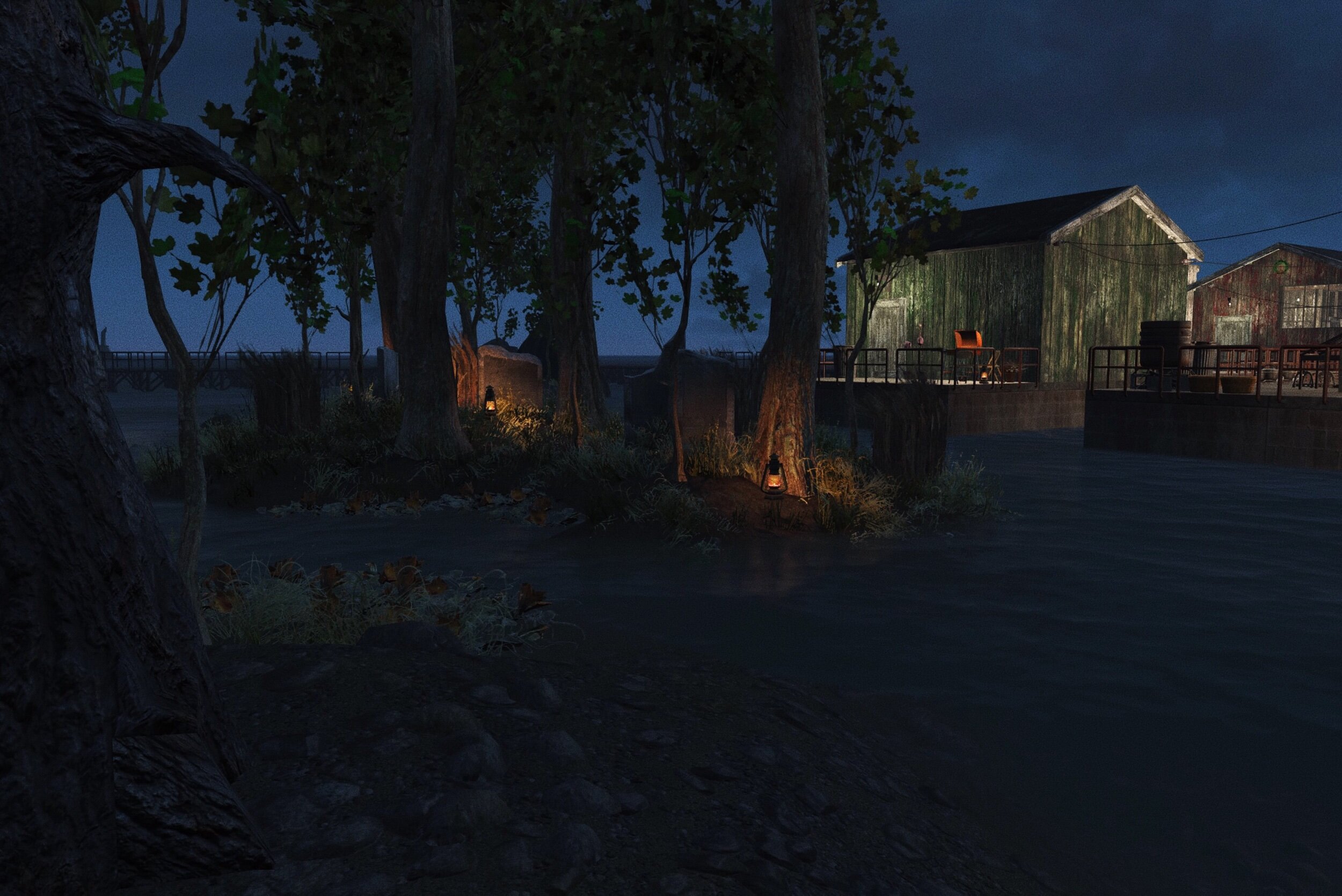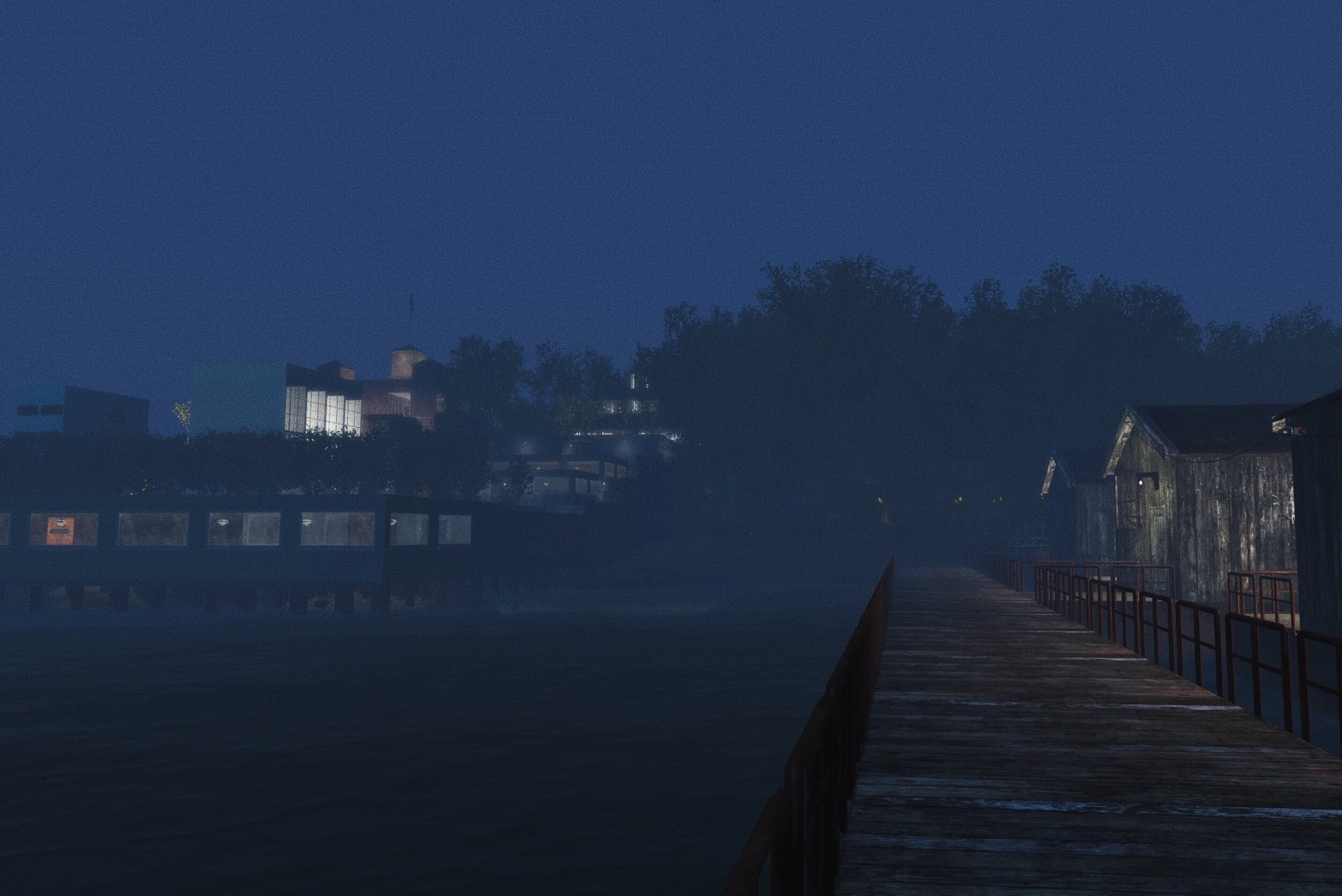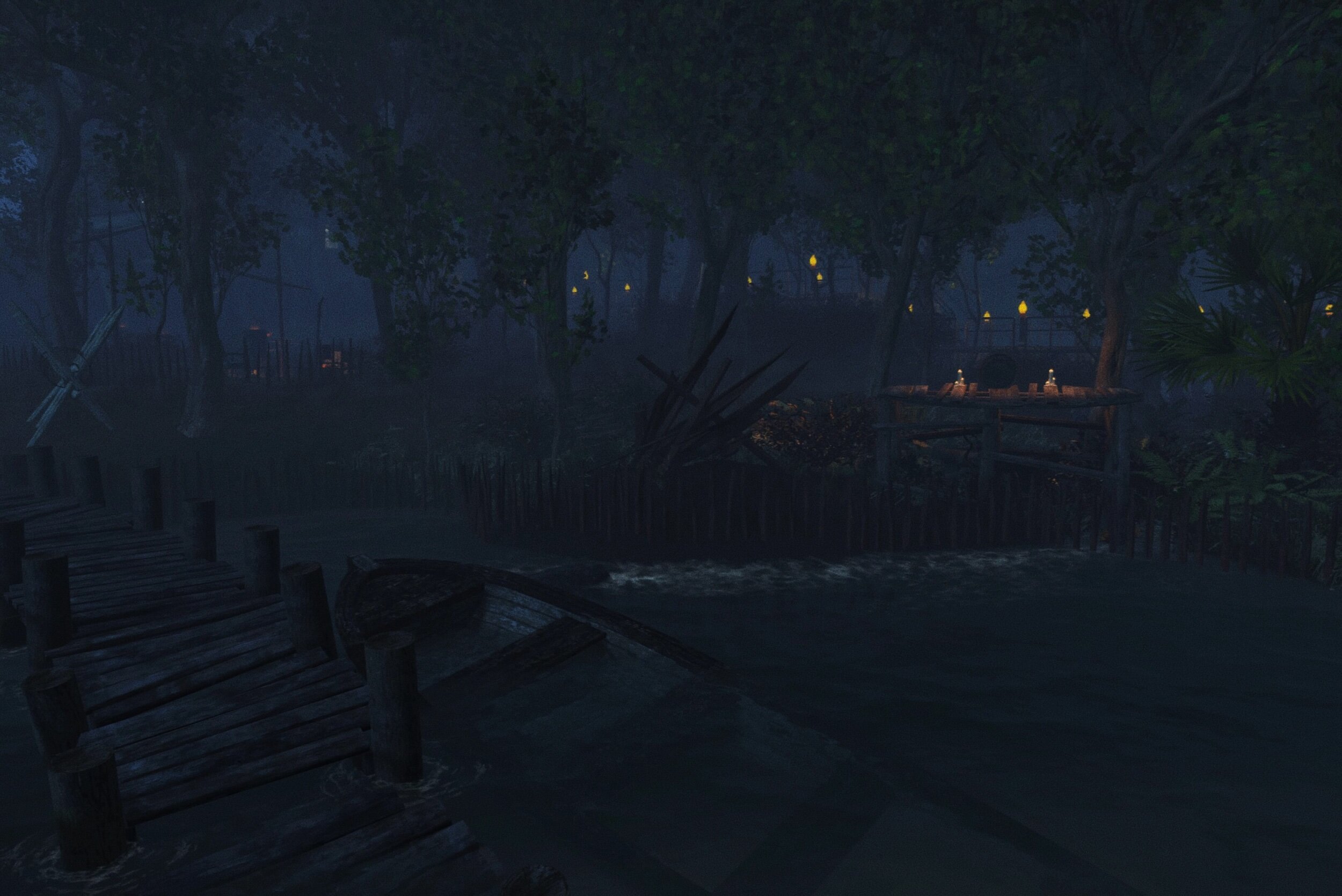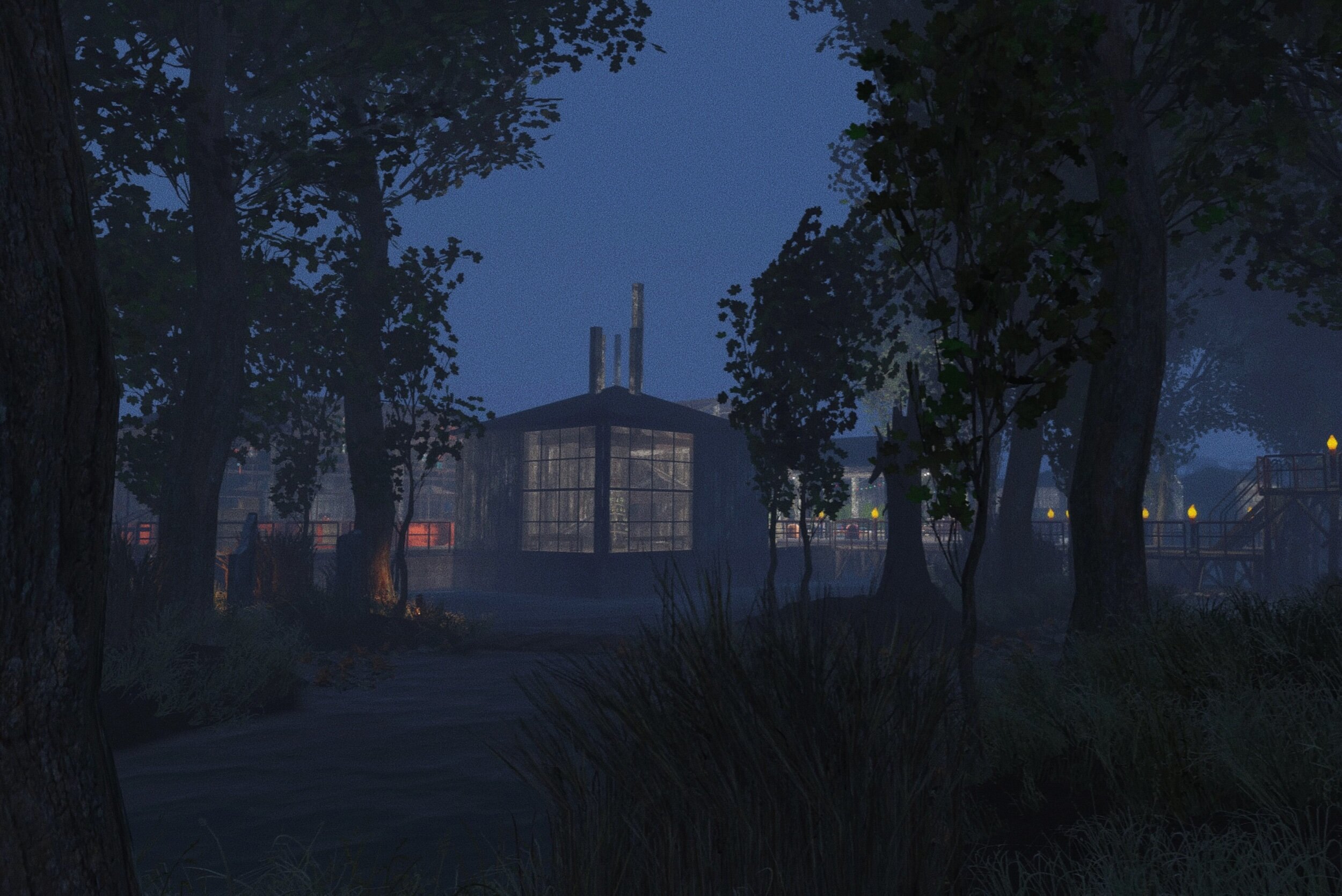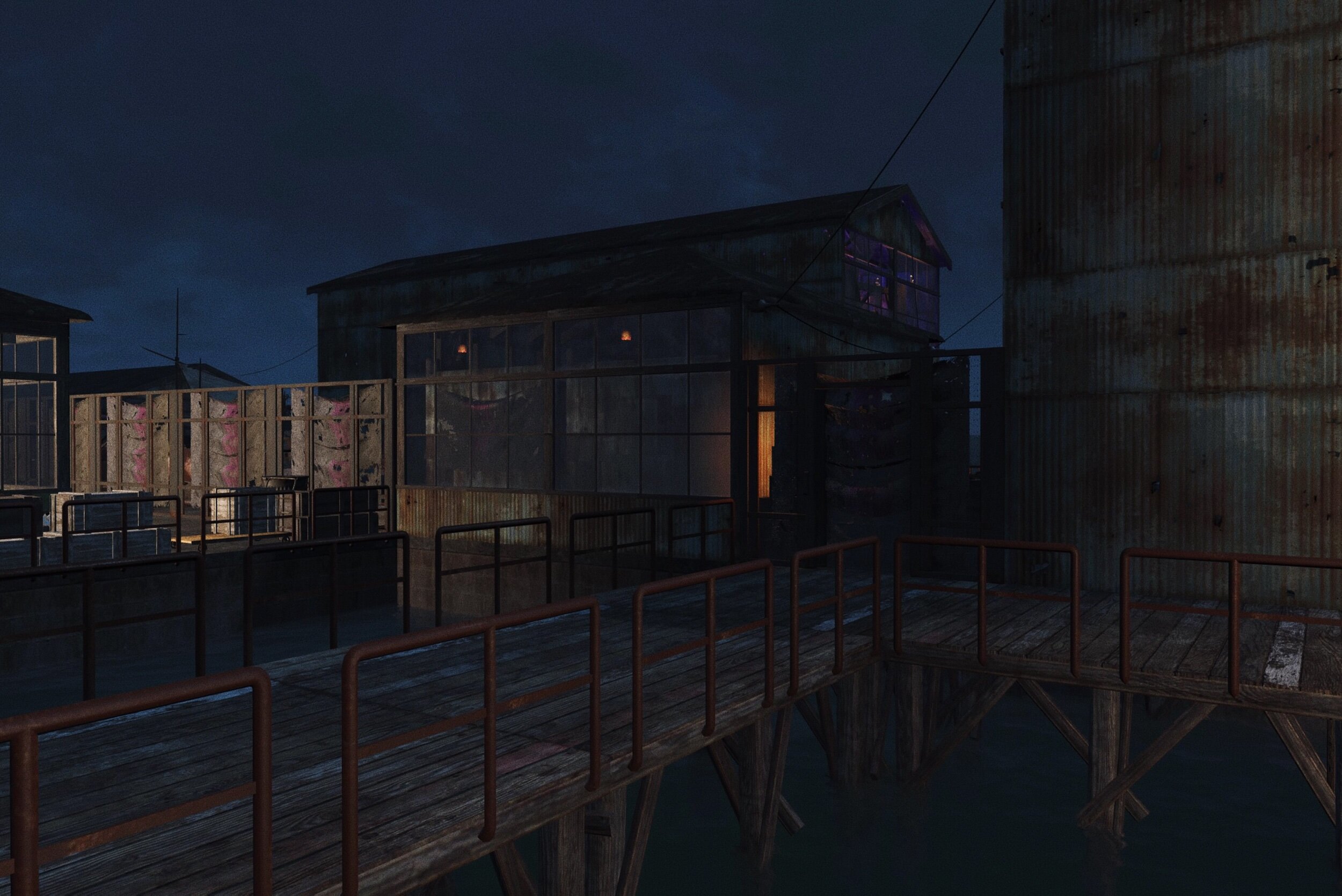Looking west towards the Town of Randy from South Randy Road. In the foreground is Old Camp Randy, the original, and since abandoned, settlement in the region.
Randy: A DARK PAST, HAUNTED PRESENT, AND unpredictable FUTURE
Part 2 of the Spectacle Island series. Includes excerpts from past articles by the Spectacle Islander.
LAST — Spectacle: the new great green jewel of the Commonwealth
Randy, officially known as the Settlement of Randy and nicknamed “Camptown,” “Randy Town” and “The Southern Third,” is a small post-war settlement on Spectacle Island in the Commonwealth. The settlement, occupying the southern third of the island, was named for Randy, a late settler who died defending the island from a 2287 Raider attack. The region is known for its divergent camps scattered throughout the forest and seashore preservations, a charming town center full of preserved historic architecture ripe for repurposing, and industry—the latter of which has also caused the region to be known for its corruption, economic crash, environmental ruin, and civil unrest.
So, what lies on the other side of the forest from the beautiful city of Spectacle? This is the story of two settlements on the same island—a juxtaposition of beautiful urban design and community development north of the border with industrial rot and environmental ruin in the south; a thriving tourist economy with a divided region on the brink of economic collapse; successful government, leadership, and security with corruption and near-anarchy; and regional influence with little-to-no name recognition.
A brief history
Fighting to preserve the environment
In 2289, when the City of Spectacle sought to develop the whole island, some members of the community began to push back, claiming the City was “straying from its purpose” and was “driven by greed” at a meeting with City Council. Concerned over the environmental impacts of development and overcrowding, tensions eventually resulted in the settlers leaving the city and setting up a camp on the coast by the bay, claiming secession from the City and sovereignty. They called the new settlement Lowland in reference to its low elevation on the island. After much deliberation, an agreement was eventually made between City leaders and residents of Lowland in which the settlement would remain part of the City as a special district, known as the Lowland District, with certain self-governing powers and, perhaps most critically, funding.
Later that year, leaders and residents of the Lowland District, concerned over the environmental implications of rapid development on the island, organized a commission with the City of Spectacle to establish a conservation easement south of the city on which no development could take place. When the City was less than eager to cooperate, residents distraught over the subsequent political back and forth left the newfound Lowland District and set up a camp on the southern shore of the island, claiming sovereignty. They staged protests outside of construction sites across the city, as well as Capital Square, where they lobbied for their own commission outside of the Capital Building every day for almost three weeks. After mass protests and more than a week of deliberation between the City and former settlers, an agreement was finally reached and a new government agency formed: the Spectacle Island Authority. The agency would manage all portions of the island not within the boundaries of the city, which is basically the southern third of the island. Additionally, it established two conservation easements: the Coastal Forest and Seashore Preservation and the Island Forest Preservation, where no development is allowed to take place. This ensured the preservation of the natural landscapes and traditional post-war structures the settlers before them lived in. The long fight for environmental preservation had seemingly come to an end. However, unbeknown to the group at the time, the fight for survival would be much harder.
Illegal mill operations as a means of survival
While the City of Spectacle got rich exploiting the environment through relentless development initiatives, the Settlement of Randy was less organized and successful starting out. Remember, these were the folks who split from the group who already split from the City. How were they supposed to make money? Where were they supposed to sleep? What would they eat? Who was in charge? These were all questions residents of Spectacle would never have to think twice about—these were common post-war hardships within a stone’s throw of pre-war-like luxury and security. Several ideas were considered in order to make money, including farming, prostitution, and supply running. While these were guaranteed ways to earn an income, they would prove futile stacked against the needs of an entire community. Eventually, some members of the newfound community decided to rule against their own morals—the ones that got them to where they were in the first place—and exploit the environment they’d fought so hard to save by assembling a tree harvesting mill and storage warehouse in order to feed and shelter themselves. Without a proper permit or training, the endeavor would not only be morally soul-crushing—it would also be dangerous and, in one instance, even deadly.
This, of course, was not a unanimous decision; in fact, it was so divisive that Camp Randy actually split in half—Camp Shore moved to the west of the southern third of the island, right below the Research Institute, complete with just about what one would expect of an outdoor commune. Meanwhile, the rest of the group moved east near the intersection of Randy Road and South East Avenue to establish Camp Sunrise and, soon after, Sunrise Mill and Warehouse, complete with a general store, cafe, market, office, residences, sawmill, and warehouse. The group made a living by selling illegally-harvested trees to construction projects or wholesalers, as well as serving as a hub for scrapped material imports with few regulations.
A new regional center for the southern third
Camp Shore remained virtually unchanged despite a change in scenery. This would remain the case for another few months until former city-dwellers grew tired of hunting and scavenging; eating, sleeping, pissing, and shitting outside in front of others; and infighting within the already fractured group. However, since many were likely banned activists, drifters, or wanted criminals, they could not simply just move back to Spectacle. Instead, the settlers formed a new settlement, known as the Town of Randy, at the southern tip of the island at the intersection of Forest Road and Randy Road. Here, a wooden town hall and three commercial buildings—all of the same design and floor plan but with differing colors—were planned. The architectural style is similar to buildings on East Avenue in the City of Spectacle. The new town, established at the intersection of two newly constructed roads out in the wilderness, was smack-dab in the middle of rivaling camps on all sides. Additionally, it was being led by totally unqualified members of the group. Nevertheless, construction began on the four planned buildings. It lasted for a couple of weeks before the group ran out of money. At the time, only the foundations had been laid.
Word about plans for constructing a new regional hub on Spectacle Island caught the attention of a developer who intended to bring the first industrial site to the island. The developer had previously worked with the City of Spectacle and other local agencies to secure land for the project, but to no avail. The developer and settlers of the newfound Town of Randy would be godsends to each other—the Town of Randy offered a home to the industrial site with a virtually painless process and significantly less regulations than the City of Spectacle, while the developer offered economic prosperity and security to the Town of Randy. The developer funded the construction of a new industrial site featuring two large warehouses, commercial space, an office, port, and residences, as well as a residential village for employees complete with 17 new houses and two commercial spaces. Finally, the developer lent the Town of Randy a loan to complete the construction of the four originally planned buildings; it also provided the settlement the ability to build a chapel, pavilion, and three new houses.
As the settlements of Randy and Spectacle grew alongside each other, the differences were day and night. Randy was founded on the principles of a few intrinsic former-settlers of Spectacle who had grown disgusted with the actions and intentions of their leaders. The fragmentation would not stop there—since, the group has split another handful of times, each also due to infighting over principles. Among the infighting, which soon turned into fighting among the newly formed factions, things were overlooked or slipped through the cracks—the late-night operation of illegal tree-harvesting at Sunrise, the establishment of a new town with virtually no leadership which, unsurprisingly, fell trap to corruption and criminal activity when the South Harbor Industry rolled into town. Since both industrial operations in the region were both illicit and undocumented by the City of Spectacle and Spectacle Island Authority, as well as made considerable contributions to deforestation and pollution in the region, and since the Town of Randy was involved, no party fared well when subpoenaed by the Court of Spectacle Island.
A bitter blow to industry
Tree-harvesting operations at Sunrise Mill were mostly carried out at night or in the early morning, while regular commercial and warehousing operations—like fishing and scrapping—were carried out during normal business hours. The residents of Beacon Heights, a high-end neighborhood in Spectacle, were, unsurprisingly, not big fans of the continuous industrial operations due to noise pollution and light trespass, among others. After the establishment of the Spectacle Island Authority, the mill was forced to shut down and leaders arrested. With a lack of leadership, money dry, and resources low, the settlement was abandoned. A hurricane hit the area in 2291, causing damage to some buildings. Though abandoned, the village was inhabited by squatters at the time of the storm, resulting in one death.
Similarly, an investigation of the South Harbor industrial site revealed a staggering scale of corruption—and pollution. The owner of the site bribed local leadership with a considerable amount of investment money in exchange for basic governing capabilities. To make a long story short, the site owner seemingly ran, or at the very least co-ran, the newly formed town, making decisions about construction, land use, and taxes, among others. The site owner, who never appeared for court, was charged and sentenced. Some say he fled back to the Commonwealth to avoid serving time on the island. While the negligent leaders of the Town of Randy were never charged, they were immediately relieved of their duties by the Spectacle Island Authority, who replaced them with their own appointees. Additionally, the governing body was audited.
After the closures of both the South Harbor Industrial Site and Sunrise Mill, dozens of islanders were suddenly out of a job. Both sites were gated off and power was cut. In time, the shininess of the new buildings on a new road in a new town wore off. The venture of starting a new town backfired as quickly as it paid off—the former leaders were ousted, the massive and economically-vital industrial operations were forced to close, and the town and its residents quickly went bankrupt. Needless to say, there was outrage and unrest.
An abandoned and cursed region
While the economic disaster settled in, some members of the community left, leaving behind their relatively new life in search of something more stable. Businesses, such as community staples like the Oyster House and Randy’s Drugs and General Store, kept their doors open despite the chaos—until a wave of violence would force the whole town into lockdown.
Later that year, a blood-chilling series of murders and violent attacks began to shake the island. New development encroached on Camp Randy, the original settlement in the region, which was also the final resting place of Randy. Pollution from illegal dumping littered the coasts, forests, and waters of the region, causing outrage. Simultaneously, the region was politically unstable and tensions among factions were heating up. Two people from the Town of Randy went missing—their bodies were later found in the Island Forest Preservation near Old Camp Randy. On separate occasions, buildings were covered in paint, had windows broken, or were partially set on fire. Additionally, stone grave markers behind Randy Chapel were damaged or toppled over. In a handful of isolated incidents, settlers were robbed or assaulted at gunpoint. Settlers in the region, oblivious of their own contributions and failures, blamed the mayhem on a curse and claimed the region was haunted. They didn’t stop there—they also blamed the curse for the region’s economic collapse, citing the curse as responsible for the deforestation, development, and pollution of the region. Others blamed the events, including the economic collapse and subsequent unrest, on the Spectacle Island Authority, claiming they spearheaded the entire series of events as part of a conspiracy since the unraveling started soon after it was established. An investigation found that while the settlers were at fault for economic and environmental degradation due to poor leadership and incompetence, the wave of violence and property destruction was likely a coordinated effort by rogue settlers of Camp Randy who remained in the Island Forest Preservation after the formation of two new camps outside of the area.
The unrest and violence caught the attention of the entire Commonwealth. Help was offered from the likes of Diamond City security, Goodneighbor Neighborhood Watch, the Institute, Commonwealth Minutemen, and the City of Spectacle Security Department, who stepped in to investigate the series of crimes and protect and secure the community until order was relatively restored. The peacetime did not last for long. A new faction made up of former employees of South Harbor, their families, and others were discovered to be illegally inhabiting the old industrial site, making the redevelopment or repurposing of the site increasingly difficult. Additionally, there are rumors circulating that the group could be sitting on a gold mine of stolen technology and valuables from around the Commonwealth, which leads investigators to believe that, if true, the group would more than likely put up a good fight to protect it.
At this point in time, the future of the region either looks really bleak or really bright. On one hand, a handful of factions, some with violent tendencies, are stationed across the region and fighting over territory between them. Caught in the crossfire is the Town of Randy, whose abandoned industrial buildings tower over the grief-stricken community, serving as a reminder of its past failures and current threats. On the other hand, those abandoned sites and crushed dreams could serve as a beacon of possibility—a future of repurposed buildings, revitalized streets, and renewed sense of community and purpose.
Neighborhoods and culture
Coastal Forest and Seashore Preservation
The Coastal Forest and Seashore Preservation is a small strip of land protected by the Spectacle Island Authority, tucked off Forest Road between the Research Institute to the north, the Island Forest Preservation to the east, the Town of Randy to the south, and the Sandy neighborhood to the west. The area, noted for its beautiful views of the bay and sunset, perfectly-preserved preservation of its distinct coastal forest and seashore ecosystem, and indigenous settlement at Camp Shore, remains a unique strip of pristine cultural and environmental preservation completely surrounded by development.
Points of interest: Camp Shore
Island Forest Preservation
Like the aforementioned Coastal Forest and Seashore Preservation, the Island Forest Preservation is a large preservation of land also protected by the Spectacle Island Authority. The pristine forest sits between Forest Road and Randy Road. Randy, a late settler who died during an attack on the island by raiders, once called the forest home. It later hosted the original settlement from the ex-Lowland group, known as Camp Randy. It was abandoned after infighting over financial hardships and principles. Today, the forest remains relatively free of commercial/residential development, industrial pollution, or occupied camps—though a number of people are still known to roam around. A graveyard sits on a small island behind Randy Chapel.
Points of interest: Old Camp Randy, Dead Man’s Island Cemetery
Town of Randy
The regional hub for commerce, community, culture, and industry, the Town of Randy was established after a split among the Camp Shore group. The Town Center basically grew alongside the South Harbor Industrial Site, the latter of which offered the settlement an array of commercial, industrial, and residential development, including the Sandy neighborhood. It turns out, the industry played a pretty significant role in the development of the town—so much so, the industry was allowed to make important decisions affecting land use, taxes, and waste disposal, all of which led to the economic, environmental, and social collapse of the region due to corruption and mismanagement. On top of this, a series of murders and other violent crimes wreaked havoc on the town, along with the ongoing illegal occupation of the old South Harbor Industrial Site by a mysterious cult-like group of former employees and their families known as Camp Scrappy.
Points of interest: Randy Chapel, Settlement of Randy Town Hall
Town Center
Sandy
Old South Harbor Industrial Site
Sunrise
Lying low and facing east, Sunrise has been called by its name long before the Lowland settlers settled the area—even long before the City of Spectacle itself (the area spills over into a small portion of the city limits). The area was given its distinct name due to the fact that it lies on the eastern shore of the island, facing the sun as it rises every morning. After the War, wastelanders, most likely from the Commonwealth, settled in the region now called Sunrise. At some point, Raiders invaded and pillaged the island, but not without a fight. The final resting place of a settler from that era exists between the former Camp Sunrise site and Sunrise Mill site. The mill, established by former settlers of Camp Randy, consisted of the unlicensed and highly illegal process of harvesting beechwood and living trees protected by the Spectacle Island Authority; it also included the collection, purchase, repurposing, and wholesale of scrapped materials. Now abandoned, the old industrial village has been preserved pretty well, despite industrial pollution and storm damage, showcasing its beautiful architecture painted red to enhance the morning sunrise.
Points of interest: Old Sunrise Mill and Warehouse, Swan of the Pond Chapel
A travel guide
Where to…
EAT—Enjoy fresh seafood at the Oyster House. Choose between locally-caught fish and oysters. Don’t leave without stocking up on a bucket of famous ice-chilled oysters from the market in the back.
DRINK—In a small town, watering hole spots may not be as bountiful. However, quality is more important than quantity here—that’s why the aforementioned Oyster House also serves as the unrivaled taproom of the region.
PLAY—Browse for gardening tools or plants at the Farm and Garden Supply Store; shop for just about anything one can imagine at Randy’s Drugs and General Store, including groceries, furniture, and pre-war finds; or enjoy the holiday lights at the Randy Pavilion, where food and toy donations are encouraged.
STAY—Well, this is awkward. We never thought someone would ever want to stay in Randy. All jokes aside, the small town does not have any hotels in operation at the time this article was written—though that could be subject to change in the future. For now, the closest hotel options are in Spectacle.
NEXT—The island is home to two large settlements: Spectacle and Randy—a juxtaposition of a beautiful, successful, and thriving city with a corrupt, divided, and rotting region. The relentless success of one settlement has placed a burden on the other. You see, Spectacle has experienced a construction, economic, and population boom unprecedented in the post-war world, and all in a brief time. Lately, the City has focused on expanding its boundaries by creating new land through land reclamation methods. Three brand new neighborhoods later, the city limits of Spectacle are virtually built-out, putting pressure on Randy to pick up the pace.
